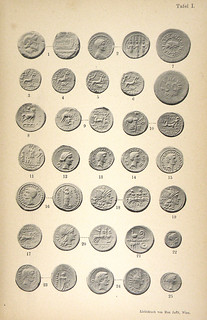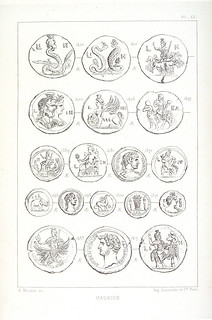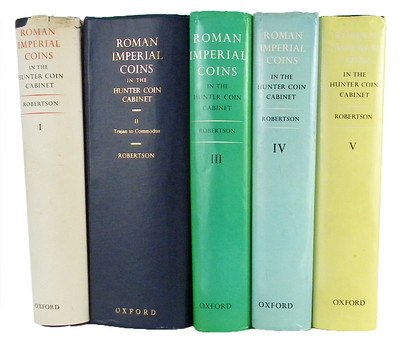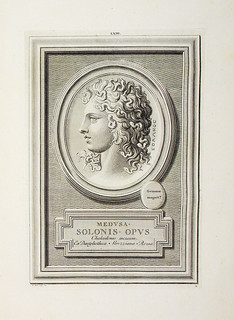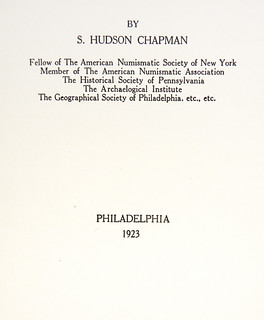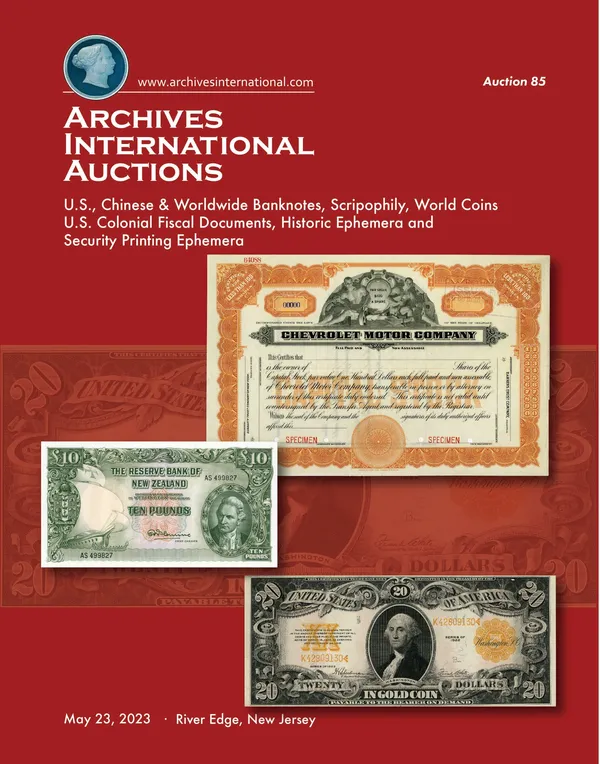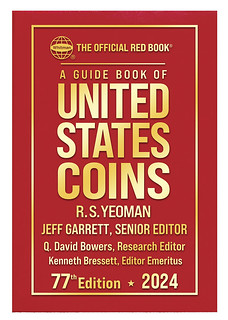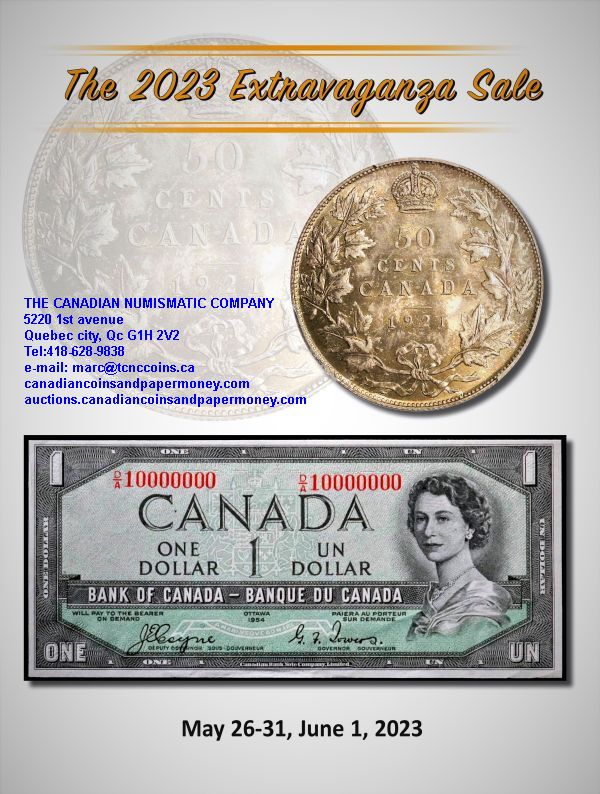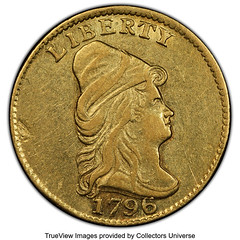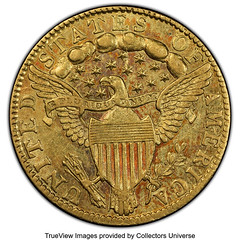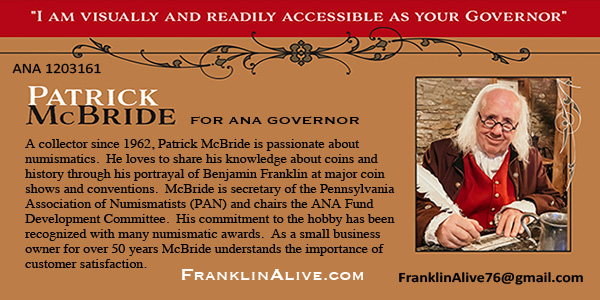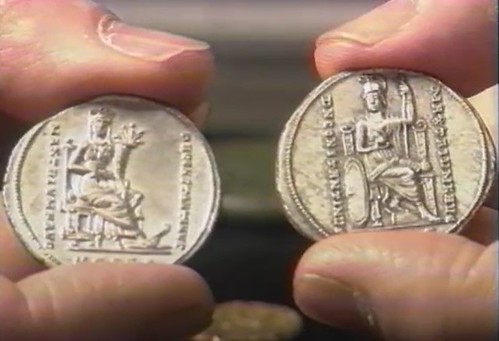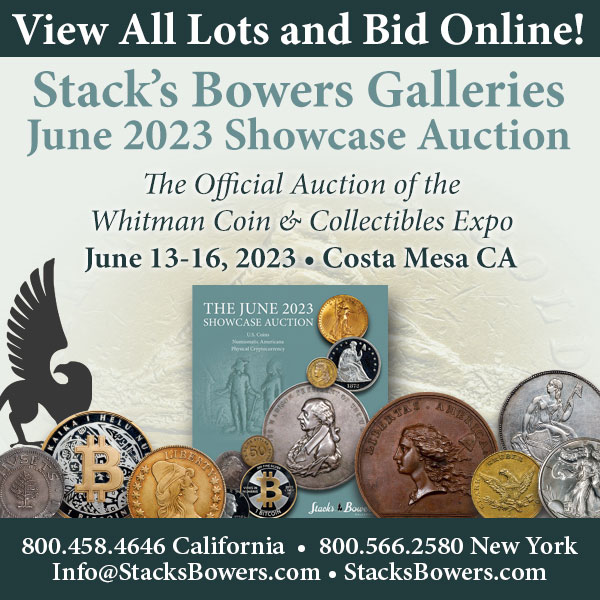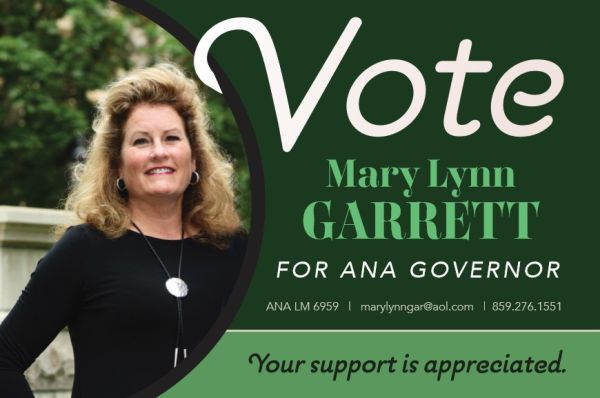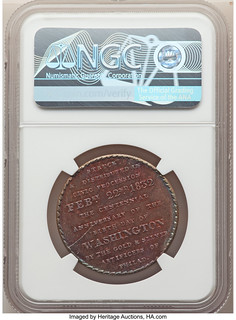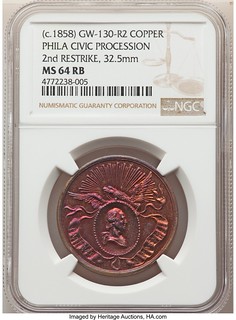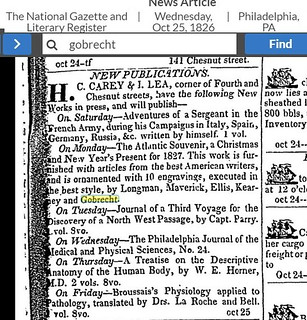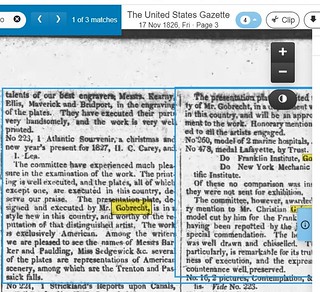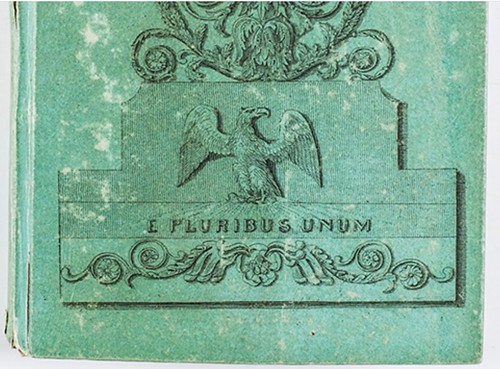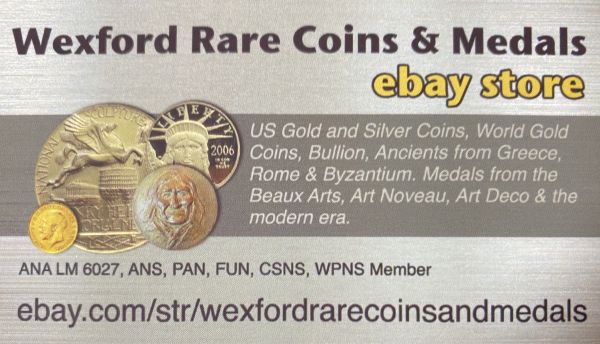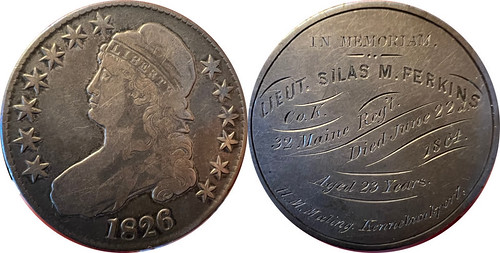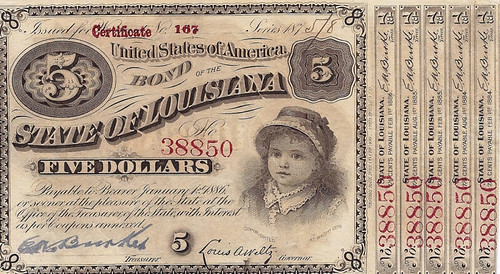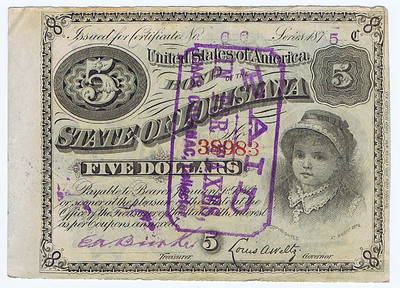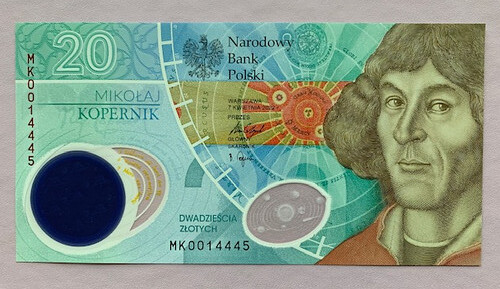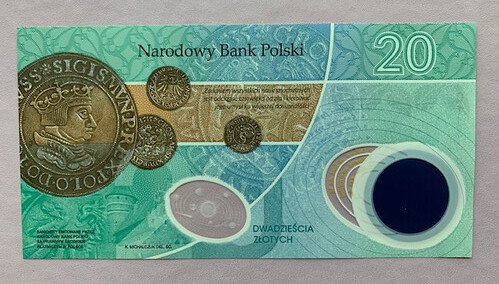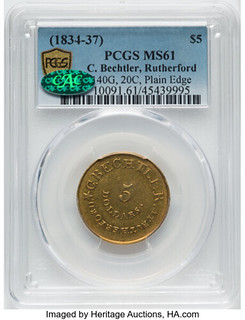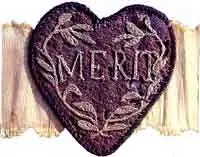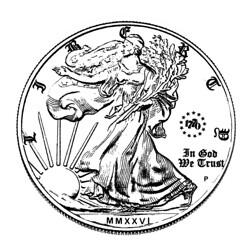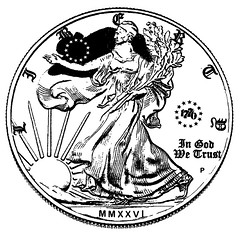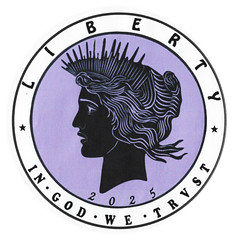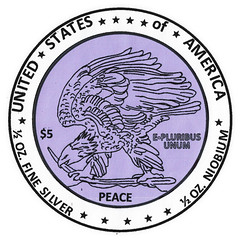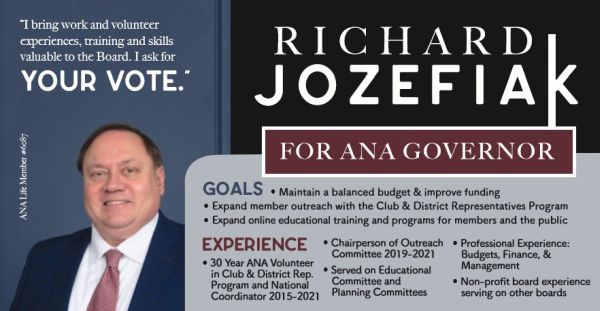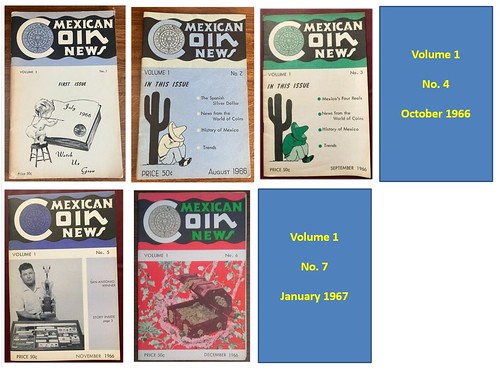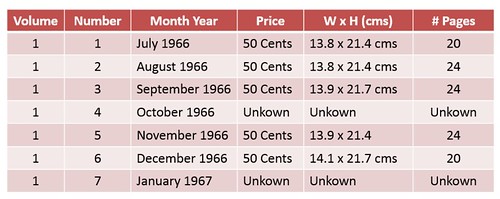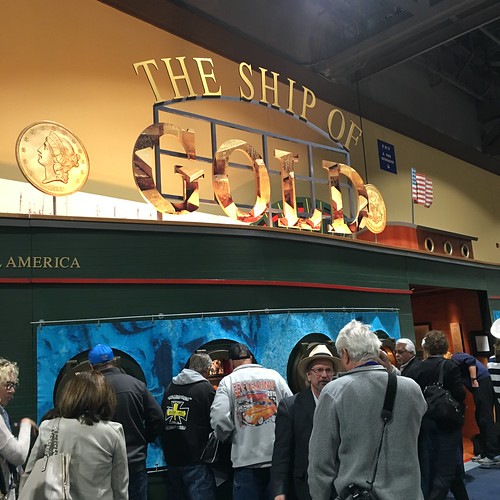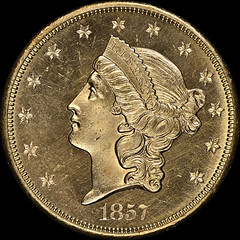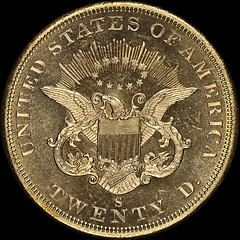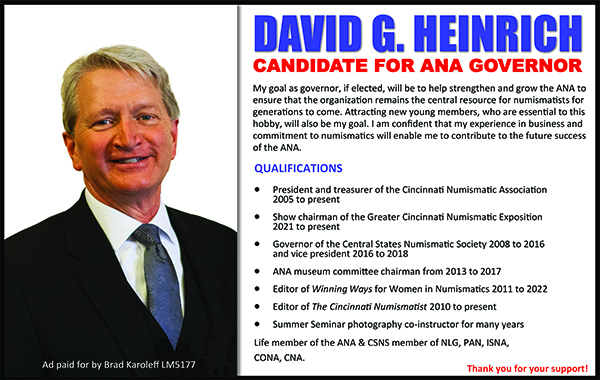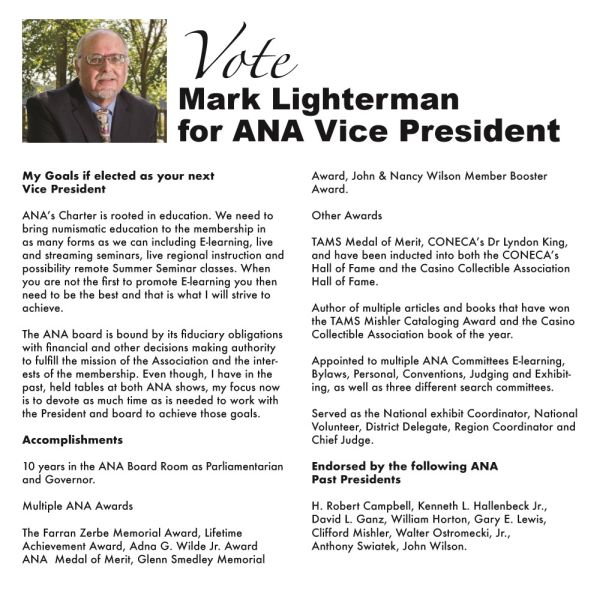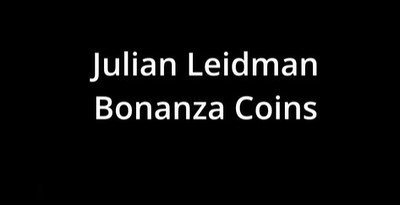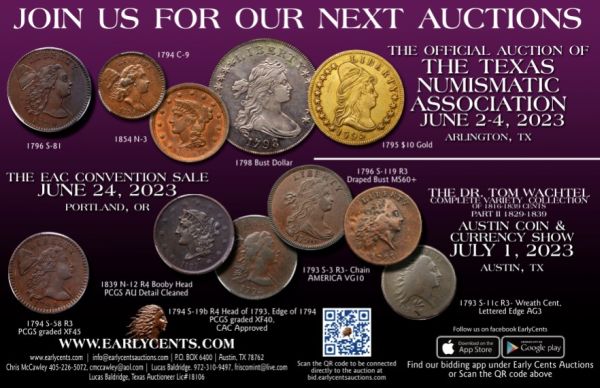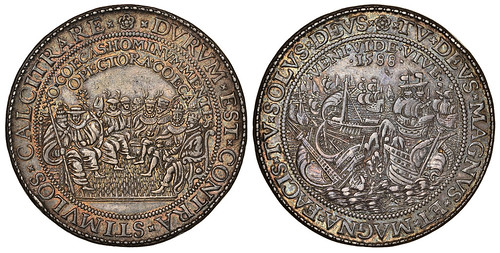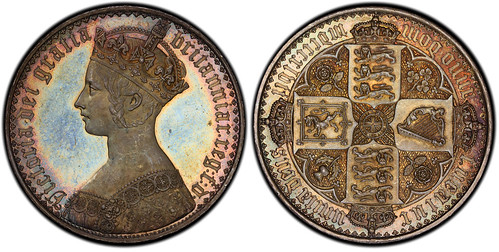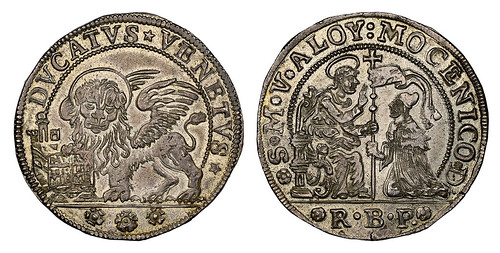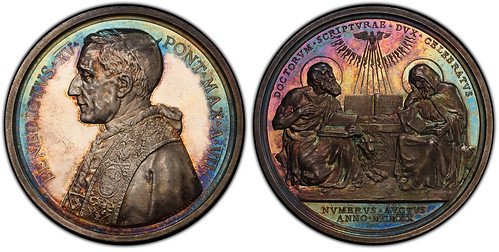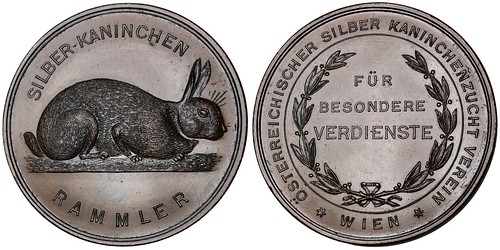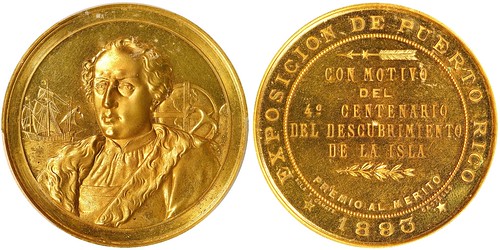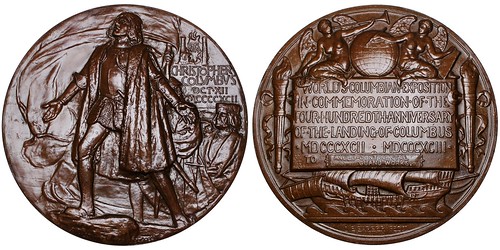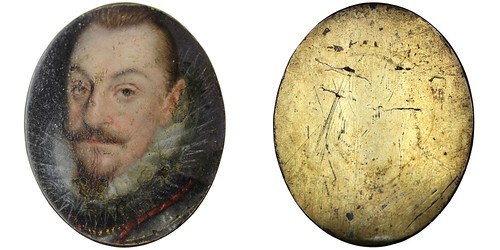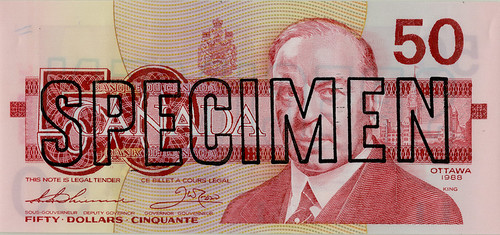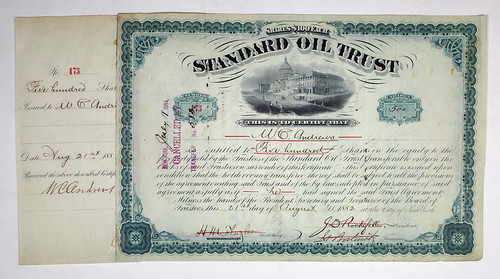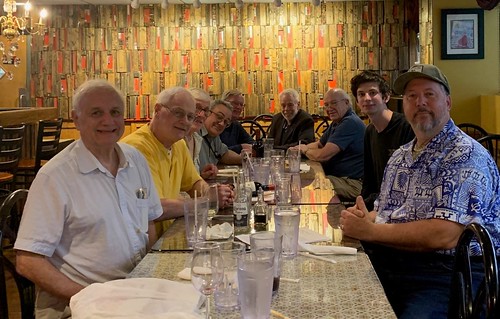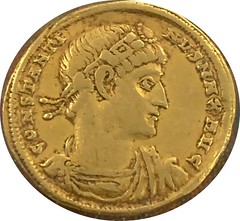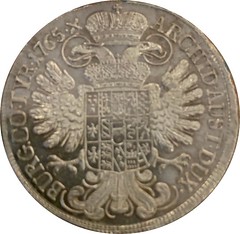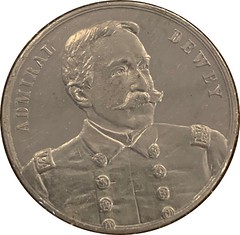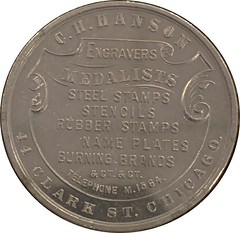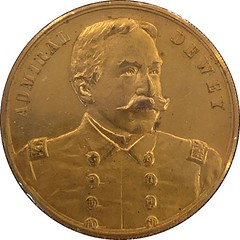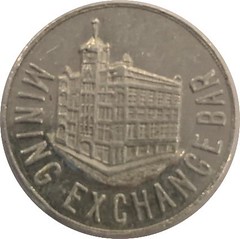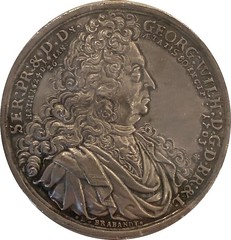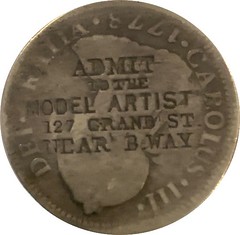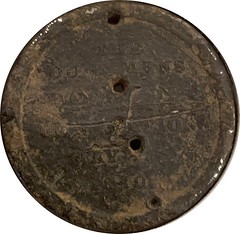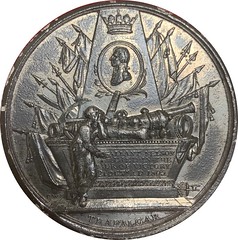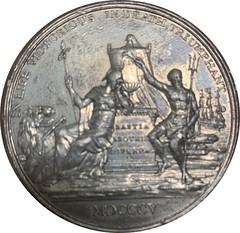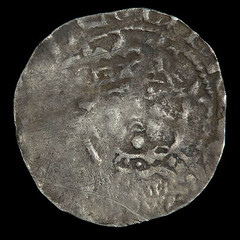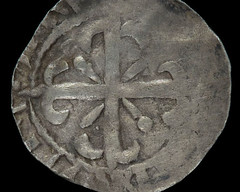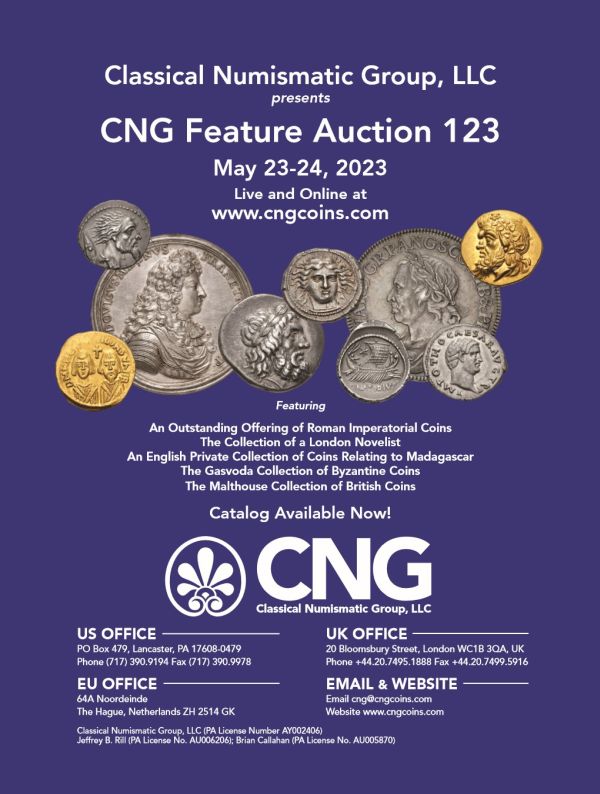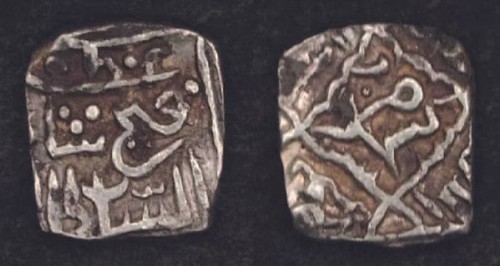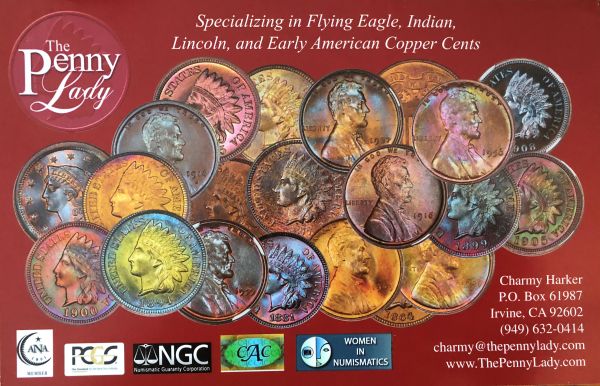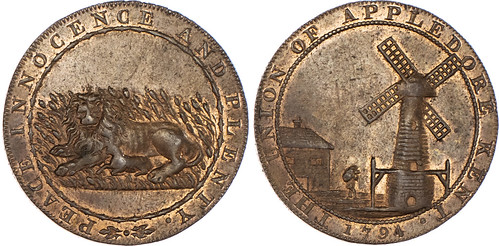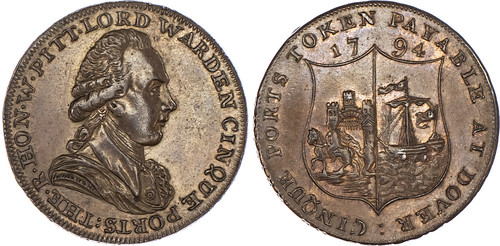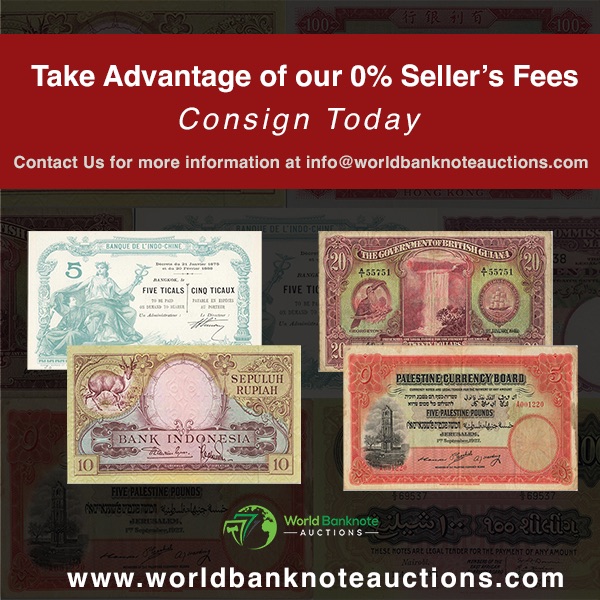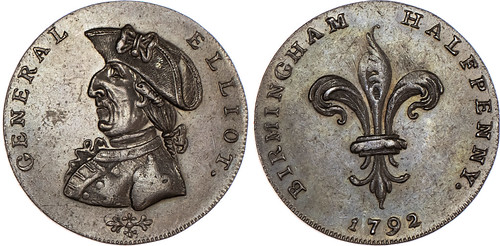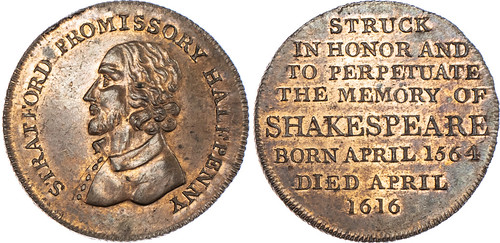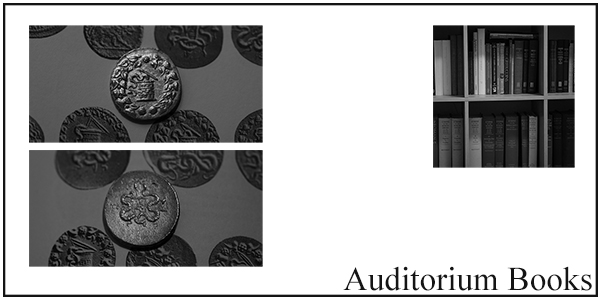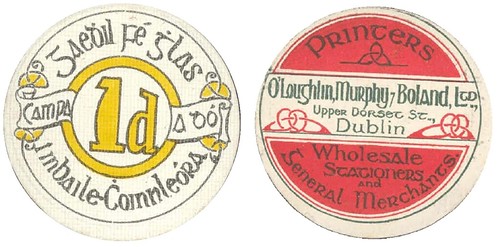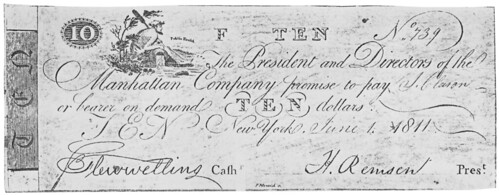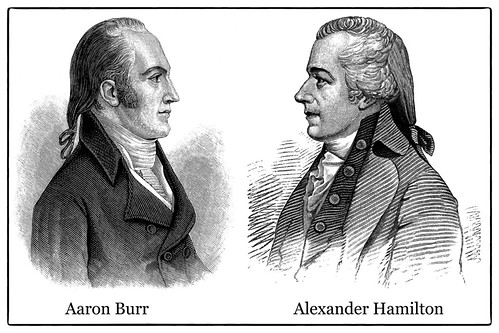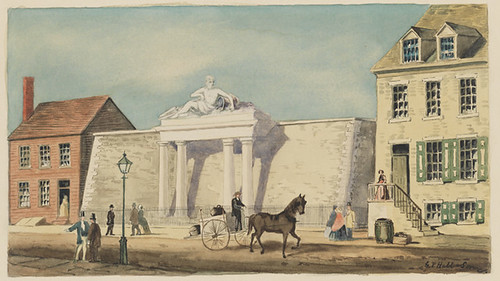
Visit our NBS Sponsors




About UsThe Numismatic Bibliomania Society is a non-profit association devoted to the study and enjoyment of numismatic literature. For more information please see our web site at coinbooks.org SubscriptionsThose wishing to become new E-Sylum subscribers (or wishing to Unsubscribe) can go to the following web page link MembershipThere is a membership application available on the web site Membership Application To join, print the application and return it with your check to the address printed on the application. Print/Digital membership is $40 to addresses in the U.S., and $60 elsewhere. A digital-only membership is available for $25. For those without web access, write to: Charles Heck, Treasurer AsylumFor Asylum mailing address changes and other membership questions, contact Chuck at this email address: treasurer@coinbooks.org SubmissionsTo submit items for publication in The E-Sylum, write to the Editor at this address: whomren@gmail.com BUY THE BOOK BEFORE THE COINSale Calendar |
- WAYNE'S WORDS: THE E-SYLUM MAY 21, 2023
- KOLBE & FANNING JUNE 10, 2023 SALE
- NEW BOOK: GUIDE BOOK OF U.S. COINS, 77TH EDITION
- NEW BOOK: POLISH PAPER MONEY 2023
- PAPER MONEY OF MEXICO
- NNP ADDS POLLOCK'S U.S. GOLD DIE VARIETIES
- VIDEO: 1997 PNG PCGS CHICAGO SUPER SHOW
- RICHARD LOBEL INTERVIEW, PART ONE
- RICHARD LOBEL INTERVIEW PART TWO
- MORE ON GOBRECHT'S ENGRAVINGS
- NOTES FROM E-SYLUM READERS: MAY 21, 2023
- QUERY: MEXICAN COIN NEWS
- SHIP OF GOLD EXHIBIT AT LONG BEACH SHOW
- SAINT-GAUDENS STATUE AT 2023 PITTSBURGH ANA
- EXHIBITS SOUGHT FOR 2023 PITTSBURGH ANA
- 2023 SUNDMAN LECTURE SERIES SPEAKERS SOUGHT
- VOCABULARY TERM: MONOGRAM
- BYRON REED (1829-1891)
- JULIAN LEIDMAN INTERVIEW, PART TWO
- JULIAN LEIDMAN INTERVIEW, PART THREE
- ATLAS NUMISMATICS MAY 21, 2023 UPDATE
- NUMISMAGRAM MEDAL SELECTIONS: MAY 21, 2023
- ARCHIVES INTERNATIONAL SALE 85
- TOM'S NUMISMATIC DIARY: MAY 21, 2023
- SCOTLAND'S KING MALCOLM IV COIN DISPLAYED
- ELEVATING NUMISMATIC STUDIES IN INDIA
- FAKE TOONIES FOUND IN NORTHERN ONTARIO
- THE 1790S BRITISH COPPER COIN SHORTAGE
- WHEN WARWICKSHIRE MADE ITS OWN COINS
- BALLYKINLAR INTERNMENT CAMP TOKENS
- WATERY ORIGIN OF AMERICA'S LARGEST BANK
Click here to read the thin version on the web
Click here to subscribe
Click here to access the complete archive
To comment or submit articles, reply to whomren@gmail.com
Content presented in The E-Sylum is not necessarily researched or independently fact-checked, and views expressed do not necessarily represent those of the Numismatic Bibliomania Society.
WAYNE'S WORDS: THE E-SYLUM MAY 21, 2023
 Thank you for reading The E-Sylum. If you enjoy it, please send me the email addresses of friends you think may enjoy it as well and I'll send them a subscription. Contact me at whomren@gmail.com anytime regarding your subscription, or questions, comments or suggestions about our content.
Thank you for reading The E-Sylum. If you enjoy it, please send me the email addresses of friends you think may enjoy it as well and I'll send them a subscription. Contact me at whomren@gmail.com anytime regarding your subscription, or questions, comments or suggestions about our content.
NOTE: I'm travelling this week, and our next issue may be delayed.
This week we open with a numismatic literature sale, three new books, updates from the Newman Numismatic Portal, notes from readers, and more.
Other topics this week include paper money of Poland and Mexico, dealer Richard Lobel, ANA convention events, monograms, fixed price and auction offerings, fake toonies, British tokens, and Irish internment camp tokens.
To learn more about early U.S. quarter dollars, U.S. gold coin varieties, the Clapp Family collection, Mexican Coin News, Byron Reed, the Gothic Crown, the Battle of the Nile medal, and Lady Godiva, read on. Have a great week, everyone!
Wayne Homren
Editor, The E-Sylum
THE BOOK BAZARRE
KOLBE & FANNING JUNE 10, 2023 SALE
Kolbe & Fanning have another great literature sale coming up - here's the announcement. -Editor
 Kolbe & Fanning Numismatic Booksellers are pleased to announce that we will be
holding our next auction sale on Saturday, June 10, 2023. The sale includes an
impressive array of rare and out-of-print works on coins, medals, and paper money from
antiquity to the present, including selections from the libraries of Louis E. Eliasberg, Sr.,
and Richard A. Eliasberg. Some highlights of the sale include:
Kolbe & Fanning Numismatic Booksellers are pleased to announce that we will be
holding our next auction sale on Saturday, June 10, 2023. The sale includes an
impressive array of rare and out-of-print works on coins, medals, and paper money from
antiquity to the present, including selections from the libraries of Louis E. Eliasberg, Sr.,
and Richard A. Eliasberg. Some highlights of the sale include:
Lot 10: a complete set of Max Bahrfeldt's classic revision of Babelon on Roman Republican coins
Lot 30: both parts of Feuardent's elusive catalogue of Giovanni di Demetrio's collection of ancient Egyptian coins
Lot 91: a complete set of Anne Robertson's comprehensive catalogue of the Roman Imperial coins in the Hunterian collection at Glasgow
Lot 114: Philippe de Stosch's 1724 folio on engraved gems, a truly outstanding classic work, part of a small but select consignment of books on the subject
Lot 136: an attractive set of Bettange's scarce and important 1760 work on the coining process
Lot 173: Wolfgang Hahn's exceptional study of early Byzantine coins
Lot 286: Louis Eliasberg's copy of the first edition of Ard Browning's foundational work on U.S. quarter dollars
Lot 293: S.H. & H. Chapman's plated 1906 catalogue of the outstanding collection formed by Harlan Page Smith
Lot 308: the suppressed first printing (1923) of S. Hudson Chapman's work on the 1794 large cents, ex Louis Eliasberg
Lot 309: the unique Clapp Family collection inventory and provenance ledger, compiled by J.M. and John H. Clapp and later part of the Eliasberg Library, recording one of the greatest collections of U.S. coins never to have been properly catalogued or sold publicly, and of enormous importance for provenance research.
Bids may be placed via post, email, fax or phone, as well as online. Kolbe & Fanning use Auction Mobility as our third-party online bidding platform. Auction Mobility is an app-based platform allowing users the ability to participate in the sale through phones, tablets and computers. To register for the sale, bidders must go to bid.numislit.com and sign up. Once you have set up an account, you may browse lots, place advance bids, or participate in the live sale online. Those wishing to participate on their devices can download the Kolbe & Fanning app through the Apple or Google Play Store. The sale will also be listed on Biddr and NumisBids in the near future.
The printed catalogue is being mailed to all active customers on our mailing list. As international mail speeds have been inconsistent, we encourage our foreign clients to consult the electronic catalogue in case their printed catalogue does not arrive promptly. A PDF of the printed catalogue has been posted to our main website at numislit.com for those who prefer that format. Bids placed via post, email, fax or phone must be received by June 9, the day before the sale, in order for them to be processed. Advance absentee bids may also be placed at any time online at bid.numislit.com. Live internet bidding will be available during the sale itself through the same platform.
Kolbe & Fanning Numismatic Booksellers LLC is a licensed and bonded auction firm in the State of Ohio, and our sales are conducted by licensed auctioneers. For more information, please see the Kolbe & Fanning website at numislit.com or email David Fanning at df@numislit.com. To register for the sale, go to bid.numislit.com. We look forward to your participation.
NEW BOOK: GUIDE BOOK OF U.S. COINS, 77TH EDITION
Here's the announcement from Whitman for the 77th edition of the classic Red Book. -Editor
Whitman Publishing announces the release of the 2024 (77th edition) Guide Book of United States Coins, popularly known as the Red Book.
The newest edition of the hobby's best-selling reference is available from bookstores and hobby shops nationwide, and from online booksellers. The 472-page book comes in several formats including the classic red hardcover, two spiralbound versions (softcover and hardcover), and Large Print.
The Red Book prices nearly 8,000 coins and coin sets in up to 9 grades each, with more than 32,000 retail valuations in total. It has many new features and updated research, plus additions to the book's 2,000-plus color photographs, which include enlarged close-ups of rare and valuable die varieties.
Coin collectors have used the Red Book to value their collections since the 1st edition was published in 1946. Today, Senior Editor Jeff Garrett coordinates the book's advisory network of more than 120 professional coin dealers and researchers. Q. David Bowers serves as research editor, and Kenneth Bressett, who has worked on the Red Book since the 1950s, is editor emeritus.
The book covers legal-tender United States coins from 1792 to date, from copper half cents to $20 gold double eagles, commemoratives, and bullion, plus earlier coins and tokens that circulated in colonial times. With every new edition the latest coins from the United States Mint are updated—Lincoln cents, Jefferson nickels, Roosevelt dimes, America the Beautiful quarters, Kennedy half dollars, Native American dollars, American Innovation dollars, commemorative coins, bullion coins, and government-packaged coin sets. The book also includes popular specialized collectibles such as error coins, Civil War tokens, Confederate coins, Philippine coins struck under U.S. sovereignty, private and territorial gold pieces, pattern coins, Hawaiian and Puerto Rican coinage, Alaska tokens, So-Called Dollars, and special modern gold coins.
The Red Book is the world's most popular annual retail price guide for U.S. coins, tokens, and other numismatic items. More than 25 million copies have been purchased since 1946, making it one of the best-selling nonfiction titles in the history of U.S. book publishing.
A Guide Book of United States Coins, 77th edition
472 pages, full color. $17.95 convenient lay-flat spiralbound (ISBN 0794850146). $19.95 classic red hardcover (ISBN 0794850154). $24.95 hidden spiral
(spiralbound hardcover) (ISBN 0794850189). $29.95 Large Print Edition (ISBN 0794850170).
NEW BOOK: POLISH PAPER MONEY 2023
Here's a Google-translated article about a new edition of the Polish banknote book. -Editor
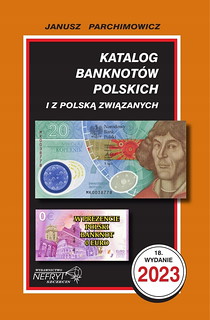 The 18th edition of the catalog of Polish banknotes, which is usually only revised and supplemented every two years, was published in April 2023. In the Internet age, when publishers have to make wise decisions about new and subsequent editions, there must be good reasons for shortening the edition of the book in this way. It will be easy to find an explanation for this, because the prices are already slightly higher on the first page with price markings (No. 13), but are greatly increased on page 14, often by 100% and more. Furthermore, if most expenses are 10-30% more expensive, this of course also has something to do with the inflation rate, which is higher in Poland than here.
The 18th edition of the catalog of Polish banknotes, which is usually only revised and supplemented every two years, was published in April 2023. In the Internet age, when publishers have to make wise decisions about new and subsequent editions, there must be good reasons for shortening the edition of the book in this way. It will be easy to find an explanation for this, because the prices are already slightly higher on the first page with price markings (No. 13), but are greatly increased on page 14, often by 100% and more. Furthermore, if most expenses are 10-30% more expensive, this of course also has something to do with the inflation rate, which is higher in Poland than here.
Friends of Polish banknotes know that the banknotes from the 19th century are so rare that you can almost only state "ca", i.e. collector's prices, because even in the usual grade IV or even V they often cost a small fortune. Chapter IV includes the certificates of the German occupation of the First World War. Here there are higher and lower prices than in 2022, but sometimes higher prices are listed for grades III and II, not for the top grades. The reason for this is simple: interest in paper money has increased so much in Poland that in the absence of good quality offers one has to be more willing to compromise even to purchase even III rated qualities for which more is charged. But quality still has its price.
Here is just an example of a not very rare note no. 53, 20 mark "General..." from 1915. This is now valued at 13,000 zloty in I, last year only at 5000 zloty and in the 2021 catalog at 2500 zloty.
Bank Polski banknotes (Chapter 8 B) also saw some sharp jumps in price, but the valuation was balanced. The market has calmed down a bit for some middle class
banknotes, but overall sharp price increases are the norm, even for pre-war notes. There are also upward price movements in the People's Republic.
Chapter XII. from page 311 contains tables on banknote series from 1944–1965. Here you can find all the series issued in tables with small pictures of the notes. At the same time, this is an addition to the 2022 catalogue: the serial letters of the editions from 1965–1993 were listed there from page 371 onwards in cooperation with Gabinet Numizmatyczny D. Marciniak. There are quite a few banknote collectors who try to collect everything there is, even if there is not a very good chance of completing it.
The cover of the new book features the 2023 collector's banknote with Copernicus, which was issued in 100,000 copies, while the 10 zloty coins are minted in a maximum of 10,000 pieces, which usually sell quickly, although many coins last even longer Time in the bank are offered. This is proof of the popularity of paper money, and cash is correspondingly popular in Poland, even though credit cards have been used for a long time.
The already 121st work, which was published by the publishing house NEFRYT, contains a little surprise again this time. On page 280 there is a "0-euro commemorative note" on the 10th anniversary of the canonization of John Paul II. The following chapter X contains these souvenir notes, for which there are already many collectors and some of which are already quite a lot costs. All in all, this book can be highly recommended to banknote collectors.
If there are procurement problems in the specialist or book trade, the company BMV Mehlhausen, 13125 Berlin, Florastraße 24 A will be happy to help at a price of €29.90 plus €4.50 shipping costs. Orders only in writing or by e-mail to: mehlhausen@snafu.de
To read the complete article, see:
2023er Ausgabe des Katalogs zum Papiergeld Polens
(https://www.geldscheine-online.com/post/2023er-ausgabe-des-katalogs-zum-papiergeld-polens)
PAPER MONEY OF MEXICO
US Mexican Numismatic Association is building an English-language encyclopedia project about Mexican currency. Who can help?
Found via News & Notes from the Society of Paper Money Collectors (Volume VIII, Number 47, May 9, 2023) -Editor
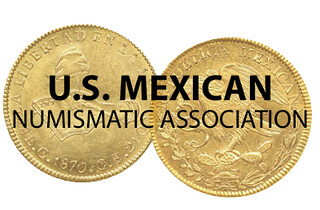 The US Mexican Numismatic Association is developing a comprehensive online history of Mexican currency, from the earliest necessity issue at the time of the War of Independence through to other emergency issues caused by the silver shortage in 1943. It includes the various national and state banks of issue, and all the private and factional issues, but not the issues of the Banco de México.
The US Mexican Numismatic Association is developing a comprehensive online history of Mexican currency, from the earliest necessity issue at the time of the War of Independence through to other emergency issues caused by the silver shortage in 1943. It includes the various national and state banks of issue, and all the private and factional issues, but not the issues of the Banco de México.
The information is presented in the "The History" section by state and in roughly chronological order. National issues and events can usually be found in the Federal District section.
Sources are, wherever possible, original documentation and so we have included texts of the relevant decrees, circulars and other correspondence in the section headed "Documents". We have also included images of many of the notes, particularly the backs, which are neglected in most catalogues but are not only often pleasing to the eye but also a deep source of information about origins, issuers and dates of use and redemption.
This is a collaborative effort and members are asked to contribute additional information. We particularly hope that other collectors will provide extra details about personnel (particularly signatories), issues, date and signature combinations, number ranges, security marks, branch overprints etc. to fill out the tables for the various banks. All contributors will be acknowledged and, where sizeable, given their own byline.
The major areas where help is needed are:
(1) Details of the bank issues – to complete the tables with dates of issue, dates on notes (not the same), series and serial numbers, signatures, security codes, overprints and any other relevant information. For serial numbers we are looking for numbers that extend the current ranges.
(2) We have a vision of doing the same with the revolutionary issues, even the exclusively local issues, tracking down details of the amounts authorised, issued and recalled, and the people and reasons behind the issues. This often depends on people having access to local knowledge or family histories.
(3) Biographies of signatories. Necessary to fill out the picture, but these also leads to amusing diversions.
(4) Images of notes where they are missing, particularly of reverses and branch overprints.
(5) We would also like to add more photographs for, even though after a while all bewhiskered Porfirians or uniformed revolutionaries appear the same, they add a personal element and better empathy. As do contemporary postcards of bank branches and other places of issue.
(6) Details of withdrawals, cancellations and incinerations. The banks publicly recorded Notes in circulation
up to the time that Carranza's commission withdrew most of their concessions: however, many continued to operate for several years into the 1920s and 1930s, redeeming their notes. With this information we can see how many notes actually survived, before another century also took its toll on their number.
(7) The text of relevant documents, e.g. decrees and circulars, and images of printed posters and flyers.
(8) References to, or examples of, previously unknown issues.
To visit the website, see:
https://papermoneyofmexico.com/
NNP ADDS POLLOCK'S U.S. GOLD DIE VARIETIES
The latest addition to the Newman Numismatic Portal is Andrew Pollock's 1995 book on U.S. gold coin varieties. Project Coordinator Len Augsburger provided the following report. -Editor
Newman Portal Adds Andrew Pollock's United States Gold Coinage Die Varieties 1795-1834
With the kind permission of Andrew W. Pollock III, Newman Portal has scanned and posted his volume United States Gold Coinage Die Varieties 1795-1834 (privately published, 1995). While the standard reference for die variety attributions is now the 2006 work Early U.S. Gold Coin Varieties, 1795-1834, by John Dannreuther and Harry W. Bass, Jr., specialists will find the Pollock work useful for the condition censes that are provided on a per variety basis. Pollock notes a 1,000+ catalogue survey,
not surprising given the extensive listings.
Images: 1796 $2.50, BD-1 (R.7) , PCGS AU55, ex. Bass Core Collection I (Heritage Auctions, 9/29/2022), lot 11004, realized $312,000. TrueView images courtesy of Collectors Universe.
Link to United States Gold Coinage Die Varieties 1795-1834 on Newman Portal:
https://nnp.wustl.edu/library/book/626540
VIDEO: 1997 PNG PCGS CHICAGO SUPER SHOW
The David Lisot Video Library on the Newman Numismatic Portal can be found at:
https://nnp.wustl.edu/library/multimediadetail/522852
We highlight one of his videos each week in The E-Sylum. Here's a Rare Coin Magazine video from 1997 recorded at the PNG PCGS Super Show in Chicago, with interviews with a number of numismatic personalities. -Editor
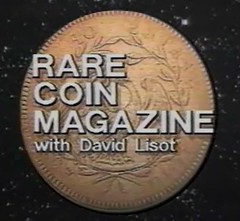 A jointly sponsored show held in Chicago by the Professional Numismatist Guild and Professional Coin Grading Service. Host David Lisot conducts interviews with Robert Brueggeman, David Hall, Richard Schwary, Donn Pearlman, Steve Ivy, Ricard Vartian, Ken Bressett, Beth Deisher, Ira Goldberg, Kenny Duncan, Harlan Berk, Fred Weinberg, Glenn Schinke, Robert Feiler, and Brent Gutekunst.
A jointly sponsored show held in Chicago by the Professional Numismatist Guild and Professional Coin Grading Service. Host David Lisot conducts interviews with Robert Brueggeman, David Hall, Richard Schwary, Donn Pearlman, Steve Ivy, Ricard Vartian, Ken Bressett, Beth Deisher, Ira Goldberg, Kenny Duncan, Harlan Berk, Fred Weinberg, Glenn Schinke, Robert Feiler, and Brent Gutekunst.
Fascinating hobby time capsule. 1997 doesn't sound so long ago to me, but a lot has changed since then. Check out the Collector's Universe computer monitor. -Editor
To watch the complete video, see:
https://nnp.wustl.edu/library/book/584313
RICHARD LOBEL INTERVIEW, PART ONE
Greg Bennick's latest interview for the Newman Numismatic Portal is with London dealer Richard Lobel. Here's the first of six parts, where Richard talks about becoming a coin collector and dealer. -Editor
Greg Bennick: Hi, everybody. My name is Greg Bennick. I'm with the Newman Numismatic Portal. And I'm doing a series of interviews with important numismatists from around the world. Today, I've got Richard Lobel with me. And Richard and I are going to be discussing Coincraft, his store and his history in coins. Richard, it's so nice to see you today.
 Richard Lobel: Nice seeing you. I'm glad I've actually got this damn thing working. (laughs)
Richard Lobel: Nice seeing you. I'm glad I've actually got this damn thing working. (laughs)
Greg Bennick: Well, I'm really glad too. It's great to see your face and to hear your voice. Well, let's just dive in. Tell me about Coincraft. My understanding is that you started Coincraft, which is your store now, but that you started it as a store in 1955 in --
Richard Lobel: Well, I started -- No. I was in collecting coins before 1955, but I date my starting in the coin business and the rest from my first paid subscription to a coin publication in 1955, still the world's greatest coin publication, the Numismatic Scrapbook magazine
Greg Bennick: That's wonderful.
Richard Lobel: I was a young kid at summer camp. I had collected coins and all of a sudden I've got this 300-page thing in front of me using words I don't understand. By the end of summer camp, it was threadbare, but I loved it.
Greg Bennick: And when you say the Numismatic Scrapbook from that era in 1955, 300 pages was one issue. I mean, those things were thick back then!
Richard Lobel: Oh yes, 360 sometimes. It was done by the Hewitt brothers in Chicago. And they were actually printers, and they had the Numismatic Scrapbook magazine, and it was so successful that they hated it, so they never sent out renewal notices. You had to remind them to renew your subscription.
Greg Bennick: Amazing. Amazing. So, when you started in 1955 then, so I guess my understanding was that you started collecting and then formed Coincraft, meaning that started in Boston, but maybe it did not. Maybe it…
Richard Lobel: No, I started -- I was 10 and a half years old, and I went to the bank in Boston where I was living, and I bought a $50 sack of pennies, 5,000 pennies, and I went through them. And I found one worth a dollar, which is fine. And I took it to the dealer, and he offered me 50 cents again, which I thought was honest. And I went home and I said, I carried that sack of pennies. I ruined my eyes. I rolled it up. I made 49 since he made 50 cents. I'm on the wrong side of the cabinet. And so I went into the coin business, buying and selling.
Greg Bennick: That's amazing. Now you were how old at that point? You said 10 and a half….
Richard Lobel: 10 and a half years old.
Greg Bennick: Okay. So, did you end up going to university then, or did you immediately get into buying and selling coins professionally and just stick with that?
Richard Lobel: I was buying and selling coins when I was at university. My father paid most of my bills, but I was a very wild youth. I have to put that. And the money I earned on the coins helped me doing some of the other things I wanted to do. But I loved it. I was lucky my father went to university with a man called Morris Murray Gould. Now he had a coin company, but he was also a numismatist. He wrote the Whitman, the first black books on Hawaiian coins, on Alaskan coins, on Puerto Rican coins, and he gave me a box of old coins. Rubbish. I mean, but to me, there was a French coin, it was a hundred years old or other coins. I mean, it wasn't worth a lot of money, but it was fascinating. And I'm fascinated with history.
Greg Bennick: That's wonderful. Now did you finish university? Did you go and finish college before delving even further into coins?
Richard Lobel: Yeah, I went to Boston University. They kicked me out twice, and I dropped out once before I got my degree. And when I dropped out the first time, I got a job in a bank as a stock transfer clerk. That's when computers were first coming in, and you took a pencil and checked the numbers across. And I got $41.31 cents a week take home pay. And one day, in my lunch, I'd go around to all the coin shops -- Boston had a lot of coin shops. And one day, I bought from Joe, I forget who -- Anyway, I bought a 1911 Canadian dime for $10. I dipped it and I sold it to JJ Teaparty, Eddie Leaventhal, for $90. And I realized I'd made $80 then, which was basically twice what I was earning at the bank. So, I decided it was better to be in the coin business full time.
About the InterviewerGreg Bennick (www.gregbennick.com) is a keynote speaker and long time coin collector with a focus on major mint error coins. Have ideas for other interviewees? Contact him anytime on the web or via instagram @minterrors.
To watch the complete video, see:
Richard Lobel of Coincraft Interviewed for the NNP by Greg Bennick
(https://nnp.wustl.edu/library/book/626832)
To read the complete transcript, see:
Richard Lobel of Coincraft Interviewed for the NNP by Greg Bennick (Transcript)
(https://nnp.wustl.edu/library/book/626831)
RICHARD LOBEL INTERVIEW PART TWO
Greg Bennick's latest interview for the Newman Numismatic Portal is with London dealer Richard Lobel. Here's the second part, where Richard talks about moving from Boston to London. -Editor
Greg Bennick: That's fantastic. Well, were certainly kindred spirits. I was asked to leave university as well and then worked out an agreement with the university and stayed. So, that's good to know that we're in good company today. Now, how did you move from Boston to England? How did that come about, and when was that?
 Richard Lobel: Well, I graduated university finally. Instead of taking four years, it took six
years because of dropping out and all the rest. And I got -- I have a degree in international
business and macroeconomics. And I was supposed to go to Harvard Business school for my
MBA. And I thought about it and I said, no. I don't really want to study. I love coins. And I
thought, and this was the big mistake. I thought I spoke the language in England. It is totally
different. It's a bit risqué
In America, a woman's fanny is her bum, her backside. In this country, it's the other side of her
anatomy. And I was with a group of guys, and I said, oh, she was really cute and I pinched her
on her fanny. And they looked at me like, what have I done? I moved here October 2nd, 1968. It
was the end of the 60s. It was still a swinging place. I had $5,000 but I owed the bank and my
aunt $8,000. So, basically, I was broke when I moved here. But I didn't care. I loved it. The
moment -- I'd been to England once before in 1964, I loved it. There's something about it. It's
the age, and it's -- you can walk down the same street every day for a year, and every day you'll
see something different. And it's....
Richard Lobel: Well, I graduated university finally. Instead of taking four years, it took six
years because of dropping out and all the rest. And I got -- I have a degree in international
business and macroeconomics. And I was supposed to go to Harvard Business school for my
MBA. And I thought about it and I said, no. I don't really want to study. I love coins. And I
thought, and this was the big mistake. I thought I spoke the language in England. It is totally
different. It's a bit risqué
In America, a woman's fanny is her bum, her backside. In this country, it's the other side of her
anatomy. And I was with a group of guys, and I said, oh, she was really cute and I pinched her
on her fanny. And they looked at me like, what have I done? I moved here October 2nd, 1968. It
was the end of the 60s. It was still a swinging place. I had $5,000 but I owed the bank and my
aunt $8,000. So, basically, I was broke when I moved here. But I didn't care. I loved it. The
moment -- I'd been to England once before in 1964, I loved it. There's something about it. It's
the age, and it's -- you can walk down the same street every day for a year, and every day you'll
see something different. And it's....
Greg Bennick: I just said it's so wonderful.
Richard Lobel: It's a beautiful life over here. In America, the people you work with, the people who live next door to you are your friends. Well, they're not really. Are they? They're people you know. Over here, it took me seven years before someone called me a friend. But I knew that they really were your friend. If you were in a fight, you didn't have to look around, that person would be there with you. And I can appreciate the honesty of this country, and they don't call you your friend because you work with them or you live next to them. If you are a friend, they really are your friend. I've had some friends here for more than 50 years and I'm still friendly with them.
Greg Bennick: Oh, that's wonderful. All of that is especially in the way that we too easily use platitudes and words like friend in the United States. I think that's really a telling point about the culture there. Now when you move there, did you intend to open a coin store or did you…
Richard Lobel: No. Absolutely not. No. It was a time of sex, drugs, rock and roll. I was very wild as a youth. I have to admit this. I've calmed down somewhat. Yeah. No, I won't go into it, but I was very wild. And I came over on a ship because I was in no hurry. I came over in third class. You shared four people in a cabin and your toilet was down the hall. But it didn't matter because it was -- you're in no hurry. And I got off the ship in Southampton. In those days, they had a boat train. They actually met the ship, and then went up to London. And everything was new. And the first place I stayed was a place absolutely perfectly named. It was called Wits End House, because you're at the Wits End. And it was a pound a night with breakfast. I never made it up for breakfast.
Greg Bennick: Of course.
Richard Lobel: And then in the middle of that, I found out that they had a heater in the room, which you had to put a Shilling in there in the middle of the night. Otherwise, you'd be cold. It was great. And I still tell the story about the navies, the guys working in the street digging the holes would wear ties because it was, you know. And I was running around London in pink and white gingham shorts. I didn't care. I loved it. I mean, I was free. I was 3,000 miles away from my family. I could do whatever I wanted and by God, I did.
Greg Bennick: I love this. And I love that you've already reframed the early history of Coincraft for me. And that in my mind, I was thinking, maybe he started Coincraft in Boston, but what I realized is you started your interest in coins in 1955.
Richard Lobel: Dealing in coins. I was dealing in coins.
About the InterviewerGreg Bennick (www.gregbennick.com) is a keynote speaker and long time coin collector with a focus on major mint error coins. Have ideas for other interviewees? Contact him anytime on the web or via instagram @minterrors.
To watch the complete video, see:
Richard Lobel of Coincraft Interviewed for the NNP by Greg Bennick
(https://nnp.wustl.edu/library/book/626832)
To read the complete transcript, see:
Richard Lobel of Coincraft Interviewed for the NNP by Greg Bennick (Transcript)
(https://nnp.wustl.edu/library/book/626831)
MORE ON GOBRECHT'S ENGRAVINGS
Paul Horner's questions and Julia Casey's potential answers have initiated some further discussion. -Editor
Len Augsburger writes:
"The reference to Gobrecht's large eagle with expanded wings for a Philadelphia token
originates from The Lives of Eminent Philadelphians Now Deceased (Henry Simpson, 1859). The exact quote is Mr. Gobrecht executed in brass the dies for embossing the morocco covers for the Boston Token from 1831 to 1836, and a die of Trinity Church, Boston, for the cover of a Paragraph Bible. Also a large eagle with expanded wings for a Philadelphia Token, and a fanciful design first used by himself for a card, and afterwards, with the lettering taken out, for a book cover.
"I've wondered whether the Philadelphia Token
refers to GW-130 to GW-133, tokens produced for the Washington birth centennial civic procession held in Philadelphia in 1832. Examples were distributed during the procession, from a horse-drawn wagon that carried the coining press. (Variants and restrikes of these tokens are legion; thank goodness for Neil Musante who has brought order to the chaos.) However, given the context of the original quote, Julia's thought that this in fact refers to The Token and Atlantic Souvenir, a Philadelphia publication (1828-1842), may well be correct."
Images: Civic procession medal, NGC MS64 RB, GW-130-R2, ex. Heritage Auctions (May 5, 2021), lot 22002, realized $288.
Link to The Lives of Eminent Philadelphians Now Deceased on Newman Portal:
https://nnp.wustl.edu/library/booksbyauthor/532900
Julia Casey writes:
"I searched around some more and I will add this to the circumstantial evidence: Gobrecht was connected to the Atlantic Souvenir for 1827, the issue when the eagle cover was made. Here are a couple newspaper clippings. And also a clearer image of the eagle from the cover."
Neil Musante writes:
"I'm inclined to agree with Julia on the Philadelphia
token issue. He probably made dies to emboss the covers of the book. I had a couple of these at one point. There's an interesting reference but I can't quite remember the title, "From Peacocks to Pigeon Feathers" or something."
Len adds:
"Edwin Wolf II catalogued embossed book covers (including some by Gobrecht) in From Gothic Windows to Peacocks (1990)."
To read the earlier E-Sylum article, see:
TOKEN AND MEDAL POTENTIAL ANSWERS
(https://www.coinbooks.org/v26/esylum_v26n19a12.html)
NOTES FROM E-SYLUM READERS: MAY 21, 2023
Query: Counterfeit 1801 Peru 2 Reales
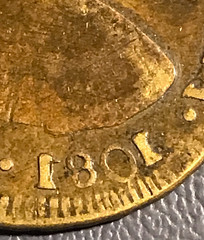 Stu Jones writes:
Stu Jones writes:
"I was wondering if you could ask the members of the news group if anyone can pass on any information about it.
I believe it's a contemporary counterfeit 1801 Peru 2 Reales. I would like to know any history on its production and any other information I can get. It is copper or brass and weighs 4 grams. It's pretty crude. Check out the 1/1 on the date."
Can anyone help? I would also recommend posting this on the Facebook Contemporary Counterfeits group page. -Editor
To read the earlier E-Sylum article, see:
NOTES FROM E-SYLUM READERS: FEBRUARY 5, 2023 : Contemporary Circulating Counterfeits Group Formed
(https://www.coinbooks.org/v26/esylum_v26n06a12.html)
More on the Silas M. Perkins Memorial Engraved Half Dollar
"I believe the H. M. Maling indicated on the coin was Henry Martyn Maling (1839-1920). Maling later married a cousin of Silas M. Perkins."
Thanks. Julia found an account of the funeral of Silas Perkins from newspaper archives. I forwarded it to Alan. -Editor
To read the earlier E-Sylum article, see:
NOTES FROM E-SYLUM READERS: MAY 14, 2023 : Silas M. Perkins Memorial Engraved Half Dollar
(https://www.coinbooks.org/v26/esylum_v26n20a08.html)
More on Pierce M. Butler
Joel Orosz writes:
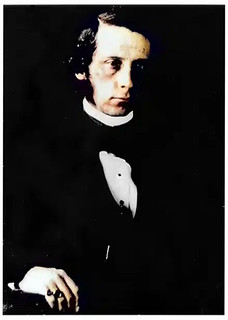 "In addition to his membership on the 1858 Assay Commission. Pierce Butler had another significant numismatic connection. His father was Dr. James Mease (1771-1846), who is credited with writing the first printed description of the U.S. Mint (in his 1811 guidebook The Picture of Philadelphia), and the first numismatic article by an American printed in the United States, "Description of Some of the Medals Struck in Relation to Important Events in North America, Before and Since the Declaration of Independence by the United States", published in the Collections of the New-York Historical Society, (Vol. 3, 1821). Mease went on to write other pioneering numismatic articles: a reprint, by the same title, of his 1821 New-York Historical Society contribution, published in Collections of the Massachusetts Historical Society (Third Series, Vol IV, 1834), and "Old American Coins", published in Collections of the Massachusetts Historical Society (Third Series, Vol. VII, 1838).
"In addition to his membership on the 1858 Assay Commission. Pierce Butler had another significant numismatic connection. His father was Dr. James Mease (1771-1846), who is credited with writing the first printed description of the U.S. Mint (in his 1811 guidebook The Picture of Philadelphia), and the first numismatic article by an American printed in the United States, "Description of Some of the Medals Struck in Relation to Important Events in North America, Before and Since the Declaration of Independence by the United States", published in the Collections of the New-York Historical Society, (Vol. 3, 1821). Mease went on to write other pioneering numismatic articles: a reprint, by the same title, of his 1821 New-York Historical Society contribution, published in Collections of the Massachusetts Historical Society (Third Series, Vol IV, 1834), and "Old American Coins", published in Collections of the Massachusetts Historical Society (Third Series, Vol. VII, 1838).
Mease married the daughter of South Carolina Senator Pierce Butler, and both of their sons secured an inheritance from their maternal grandfather by changing their surnames to "Butler." Mease at least had the consolation of being credited with being the first to add a tomato base to an ancient Asian condiment, and calling it "ketchup."
Interesting. Thanks! -Editor
To read the earlier E-Sylum article, see:
LOOSE CHANGE: MAY 14, 2023
(https://www.coinbooks.org/v26/esylum_v26n20a27.html)
Print of Miss Anna W. Williams
Patrick Parkinson passed along this offering of a newspaper illustration of model Anna Williams. Unfortunately, the item is not pictured. -Editor
A chromolithograph print of a woman's portrait used for U.S. coinage, with the caption: From the art supplement of the N.Y. Recorder, July 5th 1891. "Miss Anna W. Williams, whose profile graces the coinage of the United States." Colors in tones of tan and rose. We think the term "solargraph" was made up by the newspaper. 8 1/2 x 12"
To read the complete item description, see:
Miss Liberty, solargraph
(https://www.abebooks.com/Miss-Liberty-solargraph-Numismatics-Currency-New/31509211974/bd)
Louisiana Baby Bonds - Are they Unauthorized Reprints?
"There are some large hoards of Louisiana Baby Bonds around, the vast majority or all, could be reprints.
"I refer to a write up on ebay.... Virtually all Baby Bonds offered today, are reprints made by Edward Burke (Louisiana State Treasurer) in the 1870's from the original plates, before he absconded to South America with his ill-gotten fortune, whether printed in blue, red or green ink, with or without coupons, hole punches, in sheets etc. As such they are readily available for just a couple of Dollars, many with the same serial numbers, repeated or different dates etc.
"Some of the legitimately issued examples were redeemed as payment for taxes, and stamped by the state tax collectors, in this case, Charles Cavanac."
Thanks for the images of redeemed bonds - I hadn't seen these before. -Editor
To read the earlier E-Sylum article, see:
BABY BONDS
(https://www.coinbooks.org/v26/esylum_v26n20a25.html)
Poland's New Copernicus Note
Gosia Fort writes:
"My numismatic collection of Copernicus has been recently strengthened with a new purchase. It is a polymer banknote announced in Coin World.
"I am boasting here because this is not what I usually buy. I prefer medals or coins, so paper money is more like an outlier in my collection. In this case, I could not resist though. The features described in the announcement, such as the most popular portrait of Copernicus, the images of the heliocentric system and of the historical coins, and the image of the Castle of the Warmian Cathedral Chapter in Olsztyn, all of which are references to different roles Copernicus performed: astronomer, economist, physician, administrator, diplomat, translator make the design especially interesting to me.
"The rare book librarian in me appreciates especially one detail. A fragment of the solar system was taken from his manuscript of De revolutionibus orbium coelestium held by the Jagiellonian Library! The medical librarian in me smiles at the reference to the Olsztyn city. Copernicus was charged with organizing the defense of the city during the Polish-Teutonic War (1519-1521) and there he also successfully contained the spread of epidemic.
"I read many descriptions of this banknote but one irked me, when it mentioned that the note does not have security thread and watermark, but it failed to mention that it has other security features. This is only the second collector's polymer bank note issued by the Polish National Bank. In addition to the traditional security features such as microprints, angular effect, and iridescent stripe, it has also some amazing security features not possible on a different type of substrate, like tonal images, transparent windows, color images visible under the UV light and the most advanced optical security where the image of the earth orbiting the sun is in 3D with the movement effect.
"It is impressive, and I keep pulling out this bill very often to look at it and to enjoy it my most recent acquisition. I wish I was lucky to have a bill with a lower serial number, but I can't have it all. It still makes me happy to have it in my collection."
In an article elsewhere in this issue, the Copernicus note is pictured on the cover of a new book on Polish banknotes. Gosia provided the above photos, adding, "I put them on a pink background so the transparent fields are obvious and noticeable." Thank you! -Editor
To read the Coin World article, see:
Polish central bank honors Copernicus with commemorative note
(https://www.coinworld.com/news/paper-money/polish-central-bank-honors-copernicus-with-commemorative-note)
More on Dale Birdsell
David Fanning writes:
"Pete Smith is to be commended for his biographical overview of career criminal and overall reprobate Dale E. Birdsell, author of the monograph on Klan tokens. I was gathering information on Birdsell several years ago for an article I never got around to writing, and have this little nugget to add to his story.
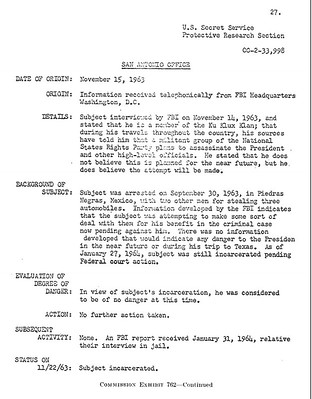 "Birdsell "was arrested on September 30, 1963, in Piedras Negras, Mexico, with two other men for stealing three automobiles. This quote is taken from the notes recorded by the U.S. Secret Service's Protective Research Section based on the FBI's interview with Birdsell while he was incarcerated.
"Birdsell "was arrested on September 30, 1963, in Piedras Negras, Mexico, with two other men for stealing three automobiles. This quote is taken from the notes recorded by the U.S. Secret Service's Protective Research Section based on the FBI's interview with Birdsell while he was incarcerated.
"Also within these notes, we read the following:
Subject interviewed by FBI on November 14, 1963, and stated that he is a member of the Ku Klux Klan; that during his travels throughout the country, his sources have told him that a militant group of the National States Rights Party plans to assassinate the President and other high-level officials. He stated that he does not believe this is planned for the near future, but he does believe the attempt will be made.
"The Secret Service report on Birdsell is dated November 15, 1963—one week to the day before John F. Kennedy was assassinated. The interview is included in the Warren Commission Hearings, which is where I found it."
Rex Stark writes:
"I knew Birdsell back in the late 70s, having met him when he made a couple of trips to Massachusetts for whatever reason. I didn't know him well, but well enough to tell that I didn't like him, didn't trust him, and absolutely didn't want to associate with him."
Thanks, everyone. Bizarre and fascinating history. -Editor
To read the earlier E-Sylum article, see:
DALE ESTIN BIRDSELL (1920-1998)
(https://www.coinbooks.org/v26/esylum_v26n20a12.html)
Newman Bechtler $5 Wooden Box Sought
"I am researching this specific Christopher Bechtler $5, sold at the May 3, 2023 Heritage auction and am wondering if you or your subscribers can help me with my dilemma.
"This coin is pedigreed to Eric Newman and last sold publicly in November 2014. In addition to the coin sale, an accompanying hand signed wooden box holder was included.
"Unfortunately, this specific box was not included in the current sale, and I am searching for it.
"I am also interested in any information (specific or general) regarding this particular box or these types of holding boxes with special regard to Eric Newman, Colonel Green and Waldo Newcomer (who all may have owned this coin as well).
"Your subscribership is unparalleled in their collective knowledge and I'm hoping that someone can enlighten me regarding these holding boxes in general, and possibly know the location of this specific one."
Interesting artifact - can anyone help locate it? -Editor
To read the complete lot descriptions, see:
1834 $5 C. Bechtler Five Dollar, RUTHERFORD, Plain Edge MS61 NGC. CAC. K-17, R.5.. ...
(https://coins.ha.com/itm/territorial-gold/1834-5-c-bechtler-five-dollar-rutherford-plain-edge-ms61-ngc-cac-k-17-r5/a/1215-3459.s)
(1834-37) $5 C. Bechtler Five Dollar, RUTHERFORD, Plain Edge, MS61 PCGS. CAC. K-17, R.5....
(https://coins.ha.com/itm/territorial-gold/-1834-37-5-c-bechtler-five-dollar-rutherford-plain-edge-ms61-pcgs-cac-k-17-r5/a/1359-3368.s)
Another Badge of Military Merit
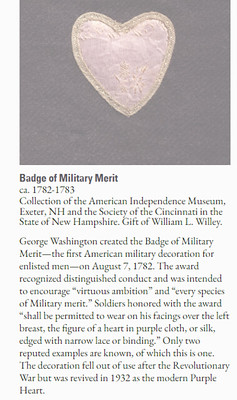 Harry Waterson writes:
Harry Waterson writes:
"There is a second Badge of Military Merit in the collection of The American Independence Museum (AIM) in Exeter, NH. See attachments. Note that it is a slightly different design than the one you pictured last week."
Thank you. -Editor
To read the earlier E-Sylum article, see:
THE BADGE OF MILITARY MERIT
(https://www.coinbooks.org/v26/esylum_v26n20a22.html)
Bullion Coin Designs
Wayne Pearson passed along some ideas for U.S. Bullion coin designs. -Editor
Wayne writes:
"Here is an idea we could use to help raise money for the national debt, by adding a silver and Niobium coin. Niobium can be made in many different colors, six are illustrated here. Purple, yellow, blue, orange, green and red.
"I found the face at this address: https://www.freepik.com/premium-vector/american-dollar-coin-handmade-black-design-vector_31256824.htm ."
Thanks. Who knows, maybe the U.S. Mint will try Niobium sometime. -Editor
Kenny Sammut
Chris Sutter writes:
 "I saw in The E-Sylum that Kenny Sammut is running for the ANA Board. I met Kenny, and his Dad, when the local club I am in, the Missouri Numismatic Society, wanted to sell its numismatic library. While it is a long story on how Kenny came to purchase the library and includes my wife and I driving from St. Louis to Philadelphia with a U-Haul trailer during the pandemic shut-down, it did end with Kenny's family treating us to a nice meal at their house. With all the restaurants shut-down, this was very much appreciated!
"I saw in The E-Sylum that Kenny Sammut is running for the ANA Board. I met Kenny, and his Dad, when the local club I am in, the Missouri Numismatic Society, wanted to sell its numismatic library. While it is a long story on how Kenny came to purchase the library and includes my wife and I driving from St. Louis to Philadelphia with a U-Haul trailer during the pandemic shut-down, it did end with Kenny's family treating us to a nice meal at their house. With all the restaurants shut-down, this was very much appreciated!
"I am very impressed with Kenny. I enjoy his Numismatic interest, drive and knowledge. He has shown a willingness to work towards his goals in life. He not only has a web-based business selling books, he is also a published writer for The Numismatist.
"I also was impressed by his relationship with his Dad. When we dropped off the books, seventy plus boxes, Kenny told me that he would run the business side of the business from his college dorm room while his Dad would do all the shipping from his home. The look on his Mom's face when she saw the seventy plus boxes sitting in her garage was very humorous.
"I hope Kenny is elected. I see this as part of a youth oriented movement within the hobby: Abigail Zechman on the FUN Board, Kellen Hoard on the CCAC, and Kenny on the ANA Board. To be honest I usually oppose this because of lack of experience issues, however I believe there have been important changes over the past few years, such as social media access, that this age group has more knowledge in addressing than mine.
"I do not want to end without telling you that I enjoy The E-Sylum. Every Monday I relax in the morning with my iPad and scroll through your offerings. I read every section and learn something new every time."
Thank you for your thoughts. I am also happy to see a youth movement in the hobby. I've met Kenny at ANA conventions, and he's been an E-Sylum supporter for some time already. I know Abby and Kellen as well. Our hobby will be in good hands with this new generation. -Editor
QUERY: MEXICAN COIN NEWS
Adrián González-Salinas of Monterrey, N.L. Mexico has a question fors readers about Mexican Coin News magazine. -Editor
Last month, I bought four "Mexican Coin News" monthly magazines (I only had the number 6 of this rare publication). So I searched the Newman Numismatic Portal and I was able to find a note that appeared in the "Missouri Journal of Numismatics" Vol. 8 (August/1983, page 15) stating that the Missouri Numismatic Society had in its library only issues 5 and 7 of "Mexican Coins News" (MCN) corresponding to December 1966 and January 1967.
I was also able to locate the book "American Numismatic Periodicals 1860-1960, Book II: An Illustrated Collectors Guide" by Remy Bourne (1990) where only 4 issues (1, 2, 3 and 6) of the "Mexican Coin News" are listed. I checked Pete Smith's e-Book "American Numismatic Biographies" (version 04 July 2021) in search of the staff of the MCN publishers (H. R. Vrooman, Margarito C. Garza and so on) but I could not find any information about them.
I also couldn't find any information about this publication (MCN) in the book "Numismática Mexicana - Una Guía de su Literatura" by Christopher M. Bolton (Mexico City, 2008).
In the book "Numismatic Bibliography" by Elvira E. Clain-Stefanelli (Battenberg-Verlag, 1985) there is a reference to MCN (page 48, # 682) but without specifying the number of issues published. I am sure that some reader of The E-Sylum has the missing issues of "Mexican Coin News" in his or her collection.
Great question. I've never seen this publication. Can anyone help? -Editor
SHIP OF GOLD EXHIBIT AT LONG BEACH SHOW
An updated S.S. Central America "Ship of Gold" exhibit will be on display at the June 2023 Long Beach Show. Here's the press release. -Editor
To mark the 35th anniversary of the
historic 1988 discovery of the greatest treasure ever found,
a $15 million Ship of Gold
sunken treasure exhibit will begin a nationwide educational tour with its first port-of-call
at the Long Beach Expo (www.LongBeachExpo.com) collectibles show in Long Beach,
California, June 22–24, 2023.
The display of recovered California Gold Rush treasures from the 1857 sinking of the fabled S.S. Central America will feature gold coins, assayer's ingots, gold nuggets, and gold dust. There will also be a bank treasure shipment box, items from the ship, and recovered passengers' artifacts including 166-year-old Cuban cigars and the world's most valuable jeans – gold prospector's heavy-duty work pants that sold at auction for $114,000 this past December.
Many of the artifacts in the updated display have not previously been publicly
exhibited. But we also will have the return of the mammoth ‘Eureka Bar' which is
considered by many to be a priceless national treasure,
said Adam Crum, president of
Finest Known (www.FinestKnown.com) in Torrance, California.

The centerpiece and highlight of the exhibit, the assayer's ingot nicknamed
Eureka is the single largest gold artifact in existence from the California Gold Rush and
the most famous and desirable artifact from what Life magazine called ‘The Greatest
Treasure Ever Found.' After its upcoming first public viewing in over 20 years, it will be
toured around the globe in a Treasures From The Deep exhibit,
he said.
The Eureka Bar weighs 933.94 Troy ounces, a little over 64 pounds. The ingot's
value in 1857 was stamped by San Francisco assayers Kellogg & Humbert as
$17,433.57, but today it's insured for $10 million,
explained Crum.
The Ship of Gold touring exhibit is being organized by Finest Known, Argos Gold Group, and National Treasures I, LLC. The exhibit is housed in a 40-foot-long recreation of the famous ship's hull.
The S.S. Central America was a 280-foot long, three-masted side-wheel
steamship carrying tons of California Gold Rush treasures from Panama to New York
City that sank in the Atlantic Ocean 150 miles off the North Carolina coast during a
hurricane on September 12, 1857. It was discovered about 7,200 feet below the ocean's
surface in 1988 by a scientific expedition using a six-ton remote-controlled submersible
vehicle,
explained Bob Evans, the chief scientist and historian on the recovery
missions.
The tragedy of the S.S. Central America sinking took the lives of 425 of the
ship's 578 passengers and crewmembers, and the loss of the gold cargo was a major
factor in the economically devastating financial Panic of 1857 in the United States,
said
Evans who will be at the Long Beach Expo to meet with visitors and answer questions
about the S.S. Central America.
The exhibit also includes a prospector's recovered saddle bag that contained
gold coins, nuggets and gold dust. Visitors can see the only known complete treasure
shipment box from the 1850s California Gold Rush period. An embossed wax seal on the box is still easily readable as Alsop & Co.,
renowned merchants and gold treasure
shippers of the era.
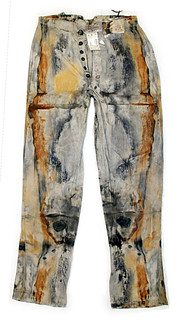 The record-setting miner's pants in the display were discovered in the
submerged trunk of first-class passenger John Dement of Oregon, a merchant and
military veteran. The display will also have items found in the trunk of first-class San
Francisco
The record-setting miner's pants in the display were discovered in the
submerged trunk of first-class passenger John Dement of Oregon, a merchant and
military veteran. The display will also have items found in the trunk of first-class San
Francisco royalty
passengers, Ansel and Adeline Easton, who were on their
honeymoon trip to New York.
After the steamship was overwhelmed and crippled by a hurricane, the captain,
Commander William Lewis Herndon, ordered the lifeboats to be launched and the
women and children, including Adeline, evacuated to a ship passing nearby. Ansel
clung to debris in the water for hours after the ship sank until the crew from another
vessel rescued him. Captain Herndon went down with the ship,
said Evans.
The Eastons were reunited eight days later when the rescue ships reached port at Norfolk, Virginia.
It has been years since the Ship of Gold exhibit has been in public, and we are
delighted to present both returning and never-before displayed historic California Gold
Rush sunken treasure artifacts for people to see in person,
stated Crum.
For additional information about treasure from the S.S. Central America, visit www.FinestKnown.com.
The June 22-24, 2023 Long Beach Expo will be held in Hall C of the Long Beach Convention Center at 300 E. Ocean Blvd. in Long Beach, California. For additional information, visit www.LongBeachExpo.com.
SAINT-GAUDENS STATUE AT 2023 PITTSBURGH ANA
Here's the press release for an interesting numismatically-related display at this summer's ANA show. -Editor
A rare example of a reduced-size early 20th-century New York City landmark statue, created by acclaimed sculptor Augustus Saint-Gaudens, will be publicly displayed at the American Numismatic Association 2023 Pittsburgh World's Fair of Money®.
Entitled Victory, the statue is reminiscent of the great artist's renowned 1907-1933 U.S. Double Eagle gold coins design. The same female model posed for Saint-Gaudens for both of those projects.
Previously in a private collection for decades, the stunning statue was purchased for $1,168,400 at a Sotheby's auction by Kevin Lipton of Kevin Lipton Rare Coins in Beverly Hills, California this past April. He now will exhibit it for the public to see at the ANA Pittsburgh convention, August 8-12.
The three-and-a-half-foot tall gilded bronze figure on a four-inch marble
base is a reduction of Saint-Gaudens' famous ten-and-half foot tall Victory statue
at the General William Tecumseh Sherman Monument in Grand Army Plaza
at the Southeast corner of New York's Central Park. It was dedicated in
1903, and only three reduction examples are privately owned, including this
one,
said Lipton.
After Saint-Gaudens died in 1907, his widow Augusta Fisher Homer Saint-Gaudens authorized the creation of eight reductions. In addition to the three privately held, five today are in the collections of museums or institutions, such as The Metropolitan Museum of Art in New York and the Carnegie Museum of Art in Pittsburgh, or at national historic sites, including Arlington National Cemetery in Virginia.
Sotheby's described the Victory statue as designed to emulate the
allegorical female figure of the Greek goddess Nike.
It took Saint-Gaudens 11 years from 1892 to 1903 to painstakingly
create the Sherman Monument and Victory statue which art critics have
described as an American masterpiece,
explained Lipton.
Owning one of these specially-made, century-old Saint-Gaudens
statues has been on my bucket list since I was a teenager and saw one for
sale at an antiques show in New York in 1977. It was priced at $60,000 back
then, well beyond the budget of a 17-year-old aspiring coin dealer from New
Jersey,
explained Lipton.
I first saw the full-size Central Park monument statue when I was a
child. Over the years, I've owned some of the most historic Saint-Gaudens
coins, including a 1907 Ultra-High Relief Double Eagle, but this statue
eluded me until recently. Now, it is time to share this masterpiece with the
public,
he stated.
The model for Victory was Harriette Eugenia Anderson who later was the artist's model for what are known today as America's most beautiful coins, the Saint-Gaudens $20 denomination Double Eagles.
The face on the statue is virtually the same as on the gold coins,
Lipton
noted.
The statue reduction that will be displayed at the ANA 2023 World's Fair of
Money convention was previously in the extensive art collection of Erving (1926-
2018) and Joyce (1927-2022) Wolf. Sotheby's described their Fifth Avenue
apartment in New York City as decorated with art that was a collection that
embodies the American spirit in such tremendous depth and breadth.
The Victory statue will be at booth #606 in Halls A and B of the David L. Lawrence Convention Center, 1000 Fort Duquesne Blvd., Pittsburgh, Pennsylvania, the site of the ANA 2023 World's Fair of Money.
For additional information about Kevin Lipton Rare Coins, call (310) 712- 8118. For additional information about the ANA convention, visit www.WorldsFairofMoney.com.
EXHIBITS SOUGHT FOR 2023 PITTSBURGH ANA
Speaking of ANA exhibits, it's time to reserve cases for the exhibit area. Why not show off part of your collection? -Editor
Display an Exhibit at an ANA Convention
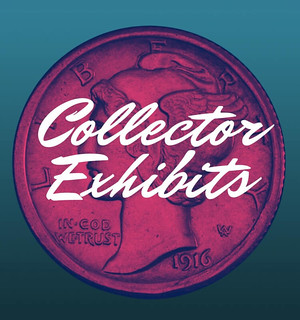 The Collector Exhibits at ANA Conventions is one of the best attended and most interesting parts of the show. There are educational displays on every area of numismatics from ancient coins and artifacts, tokens and medals, world coins, to modern United States coins and paper money.
The Collector Exhibits at ANA Conventions is one of the best attended and most interesting parts of the show. There are educational displays on every area of numismatics from ancient coins and artifacts, tokens and medals, world coins, to modern United States coins and paper money.
The individual creativity is rivaled only by the quality and variety of the items on display. Each display invites the viewer to Discover and Explore the World of Money. Members are invited to share their knowledge, research, creativity and collections with other members and the general public at ANA's annual conventions by preparing and displaying a numismatic exhibit.
The ANA Board of Governors has authorized incentives to help offset the cost of exhibiting at ANA conventions. Exhibitors who win class awards, in addition to the medals given since 2002, will win a silver eagle for third place, proof silver eagle for second place, and tenth-ounce gold eagle for first place. Best of Show winners will receive tenth-ounce gold eagle for second runner-up, quarter-ounce gold eagle for first runner-up, and Best of Show will win a half-ounce gold eagle.
To encourage show attendees to visit the exhibit section, they will be given a raffle ticket at registration that can be deposited in the exhibit area for an hourly drawing for a silver eagle.
The deadline to apply to exhibit is June 12.
Bibliophiles and NBS members, don't forget - there is a special exhibit category for Numismatic Literature that NBS raised funds to endow. Let's have some fun and promote the hobby. -Editor
Class 17 – Numismatic literature (Aaron Feldman Memorial)
Printed and manuscript (published or unpublished) literature dealing with any numismatic subject.
For more information, or to complete your application, see:
Display an Exhibit at an ANA Convention
(https://www.money.org/numismatic-events/convention-exhibits)
2023 SUNDMAN LECTURE SERIES SPEAKERS SOUGHT
And while we're on the topic of the ANA, it's also time to plan presentations at the Sundman Lecture Symposium. E-Sylum readers are experts in just about everything numismatic, and would make for perfect speakers. The deadline for making those arrangements is coming up soon. -Editor
Present Numismatic Knowledge During the Pittsburgh World's Fair of Money®
Submissions are being accepted for the Sundman Lecture Symposium, taking place during the American Numismatic Association's (ANA) Pittsburgh World's Fair of Money, August 8-12. The theme this year is "The Numismatics of Nation Building; Money, Medals, Tokens and National Identity," which focuses on how coinage, paper currency, medals and tokens have been used to create, record and/or modify national identity since the ancient Greeks used their money to announce the creation of new states.
Presenters should focus on how numismatic objects record the ideals, events and art of a nation which form national identity and illustrate the evolution of that identity over time. The Symposium will be held at the David L. Lawrence Convention Center on Wednesday, August 9, 10 am to 4:15 pm.
 To become a speaker, submit a summary of your lecture proposal, not to exceed 500 words. The summary should contain an introduction, a brief discussion of the subject, and sources and research method. Electronic submissions are preferred, but not required. Submissions should be sent to Douglas Mudd at mudd@money.org. The deadline for submission is June 2. Presenters will be notified if they have been selected by June 16. Lectures from the Symposium will be published on the ANA's website and selected presenters will receive a $250 honorarium.
To become a speaker, submit a summary of your lecture proposal, not to exceed 500 words. The summary should contain an introduction, a brief discussion of the subject, and sources and research method. Electronic submissions are preferred, but not required. Submissions should be sent to Douglas Mudd at mudd@money.org. The deadline for submission is June 2. Presenters will be notified if they have been selected by June 16. Lectures from the Symposium will be published on the ANA's website and selected presenters will receive a $250 honorarium.
For more information, see:
Apply to Present at the 2023 Sundman Lecture Series
(https://info.money.org/sundman-application)
VOCABULARY TERM: MONOGRAM
Here's another entry from Dick Johnson's Encyclopedia of Coin and Medal Terminology. -Editor
Monogram. A letter, combination of letters, or symbol forming the designer's, engraver's, or sculptor's signature on a numismatic item, sometimes in artistic arrangement. Monograms often have the last name's initial in the center if three or more letters are present (particularly if a center letter is larger), so the sequence of letters is not always certain. Other monograms may appear on a coin or medal as well; the issuer's initials, or the initials of the subject, as the Pan Pacific Exposition used a monogram of back-to-back Ps with an overlaid X. Monograms are indexed in the order the initials appear, or sometimes by all initials in the symbol.
Monograms often appear small on the coin or medal. Deciphering them is sometimes difficult due to the state of the die, or the condition of the piece. They are most often located in the lower right position of the piece, but can be located anywhere (or hidden in the design!). If a truncation of a bust or portrait is present, this can be used for the signed initials. Below or on the side of the listel separating the exergue from the rest of the design is also popular. Additional letters sometimes appear with the monogram, these identify the task of the signer: engraver, designer, sculptor, medalist. For a list of these see signature. A notable monogram is the P and X for Christ, called a christogram, used as a device on Roman, Byzantine and medieval coins from the 4th century forwards with the rise of Christianity.
To read the complete entry on the Newman Numismatic Portal, see:
Monogram
(https://nnp.wustl.edu/library/dictionarydetail/516354)
BYRON REED (1829-1891)
E-Sylum Feature Writer and American Numismatic Biographies author Pete Smith submitted this article on Omaha collector Byron Reed. Thanks! -Editor
Smarty-Pants question of the week: What do Norman Bateman, Frank Collins and Frank Howe have in common? No need to wait until next week to learn the answer. It is revealed in the article to follow.
When Byron Reed died, he was the richest man in Omaha. He gave his collection of books and coins to the City of Omaha. That was the end of one story and the beginning of another.
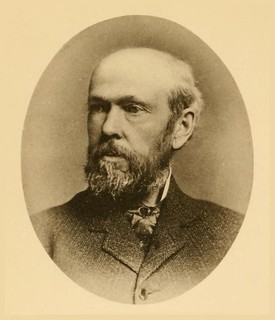 Byron Reed was born in Darien, New York, on March 12, 1829. His father was Alexander Reed
(1792-1869) and mother was Betsay Crosby Reed (1797-1864). When he was thirteen, the
family joined a group to settle in Darien, Wisconsin, named after Darien, New York.
Byron Reed was born in Darien, New York, on March 12, 1829. His father was Alexander Reed
(1792-1869) and mother was Betsay Crosby Reed (1797-1864). When he was thirteen, the
family joined a group to settle in Darien, Wisconsin, named after Darien, New York.
Reed had only an eighth-grade education but taught himself Morse Code. He worked as a telegraph operator in Warren, Ohio.
Reed moved to Omaha in 1855, the year the city was founded in what had been Indian territory. He soon ventured into Kansas as a correspondent for the New York Tribune. A pro-slavery lynch mob hastened his return to Omaha.
He produced the original survey of the city. He opened the first real estate office in Nebraska Territory in March of 1856. The Byron Reed Company was sold by the family but remains in the property management business in 2023.
Reed served as City Clerk from 1860 to 1867; as deputy County Clerk 1861 to 1863; and County Clerk 1863 to 1865. He served on the Omaha City council in 1871 and as president in 1872.
Byron married Mary Melissa Perkins (1845-1943) on April 29, 1862. If my calculations are
correct, he was 33 years, 1 month and 17 days old. She was 16 years, 9 months and 26 days old.
In a 1935 interview she recalled, There were several suiters but I rather thought Mr. Reed was
the finest of them. He was sober and hard working.
She outlived him by more than 50 years.
One child died in infancy. A son and daughter survived.
In 1875, Reed built a home at the corner of Twenty-Fifth and Dodge Streets in Omaha. In 1917, Father Edward Flanagan rented the boarding house there as his site for the Father Flanagan Home for Boys. Withing two years, they outgrew the property for what would become Boys Town.
Reed surveyed and laid out residential subdivisions and became wealthy through his investments in real estate. He acquired property around what would be the Prospect Hill Cemetery and donated it to the city.
Reed was appointed by President Harrison to serve on the Assay Commission in 1890.
Omaha's richest man became ill and died at home in Omaha on June 6, 1891. He is buried in Prospect Hill Cemetery on land he donated to the city. Also buried there is his wife Mary Melissa Perkins Reed ((1845-1943), his son Abraham Lincoln Reed (1865-1952) and daughter-in-law Thede Adeline Capron Balch Reed (1873-1946).
Byron's father, Alexander, was a collector of coins and books. Byron extended the collection to include examples of almost all United states coins issued through his death in 1891. He also collected rare books, manuscripts and autographs.
Reed's will provided funds to build a city library, art gallery and museum at 1823 Harney Street and donated his collections to be preserved at that library. The history of the collection is as complicated and interesting as the life of Reed.
The exhibit was within a museum on the second floor of the new library building. It was initially a popular attraction for visitors. It soon became a popular attraction for thieves.
The exhibit opened to the public on April 30, 1895. In December of 1895, burglars came through a window and broke a panel in the door before being scared off by alarms. In 1898 a man secreted himself in the building overnight. He failed to gain entry to the collection room and killed himself with a pistol shot in the morning before he was discovered.
In one case the alarm worked properly but the telephone company delayed in reporting to the police and the police delayed their response to the scene. That burglar was not apprehended.
In 1900 an attempt was made to rob the collection. The attempt failed when Frank Howe sawed through a padlock, set off an alarm and was quickly arrested.
In 1907 a thief overpowered a night watchman in a struggle and made off with 103 recent coins worth $146.66.
In February of 1908, burglars broke into the adjacent Boyles College building and attempted to span the ten-foot gap between the two buildings with a ladder. The ladder was too short and the plot abandoned.
In 1909 Norman Bateman was convicted of attempting to rob the collection and sentenced to twenty days in custody. He was in possession of a wood rasp used to pry open a case. He claimed that there was an innocent explanation and he used the rasp to comb his hair.
On January 2, 1930, an ambitious burglar possibly named Frank Collins broke through a basement window, pried open an iron screen, broke through an iron grating and drilled holes through a wooden door. He set off an alarm when he reached through to unlock the door. Under his real name of S. H. Fisher, he was sentenced to two years in prison.
In 1955, the American Numismatic Association held their annual convention in Omaha with the encouragement of Omaha resident and president of the ANA, Dr. J. Hewitt Judd. No burglary attempts were noted during the convention.
In 1963, a man ran from the building with police in pursuit, He left a set of burglar tools behind.
In August of 1963, three men tied up three employees and a police officer on the third floor. They were thwarted by a steel door and left behind burglary tools when scared off by an alarm.
In March of 1965 it was reported that the American Numismatic Association would build their headquarters next to the Joslyn Museum in Omaha. One proposal was to loan the Reed collection to the ANA. It is my understanding that the ANA headquarters was built somewhere else.
In May of 1965, thieves cut a hole in the wall of the Byron Reed room at the library. They were surprised by the building engineer and fled. Had they stuck around, they would have discovered that the collection had been removed from the library and placed in a bank vault.
While Reed had donated land for the library and donated his collection to the library, he left no endowment to cover costs of security. The collection was underutilized and poorly managed. Items disappeared and others were switched for lower quality examples. City officials saw the security costs as a drain on their resources while a sale would be a great boost to their resources.
Melvin Stark was numismatic curator for the Boys Town museum. He was a volunteer at the library producing an inventory of the Reed collection.
In 1972 the city council attempted to sell the collection to raise money for a new library. Melvin Stark alerted the numismatic community and fought the sale. In 1985 the city transferred the collection to the Durham Museum. In 1996 the city sold off parts of the collection through an auction by Spink. The sale realized $5.8 million with three million going to the Durham Museum and the rest to the city.
In 1978, a successful break-in was made at the U. S. National Bank vault where the Reed collection was stored. ANA President Grover Criswell was in town and wanted his picture taken with the mayor and some of the Reed coins. The vault door required two combinations, one held by the Byron Reed Historical Association and the other under the care of City Council representative Richard Takechi. When called on to open the safe, he could not remember the number. A locksmith was called and the safe was drilled open.
Takechi said that for security reasons, it should not be known that he had one of the
combinations. When asked what happened, he said, I'm not going to tell you. If this comes out,
I'm thinking of resigning.
Of course, this was reported in the local paper.
In 1986 the city council approved an agreement to loan the Byron Reed Collection to the Omaha History Museum.
The surviving collection was put on display at the Durham Western Heritage Museum in the art deco Union Station at 801 South 10th Street. Dr. Larry Lee mounted the exhibit while he was curator there. The exhibit was opened in 1999.
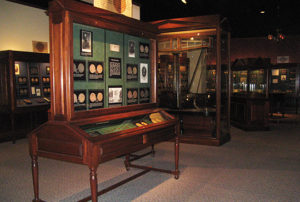 I attended the National Token Collectors Show in Omaha over Labor Day weekend in 2007. On
the morning before the show opened, I toured the exhibit at the Durham Western Heritage
Museum.
I attended the National Token Collectors Show in Omaha over Labor Day weekend in 2007. On
the morning before the show opened, I toured the exhibit at the Durham Western Heritage
Museum.
Less than a year later, on April 6, 2008, the name was changed to the Durham Museum. While the ANA Museum tells the story of coinage to the general public, I found the Durham Museum more interesting. It includes an exhibit of numismatic literature and extensive exhibits of great coins and tokens. I highly recommend it.
JULIAN LEIDMAN INTERVIEW, PART TWO
Greg Bennick's latest interview for the Newman Numismatic Portal is with dealer Julian Leidman. Here's the second part, where Julian talks about some favorite coins and the Wilkison collection. -Editor
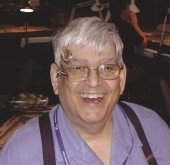 But I guess my favorite coin is what I'm always going to call Judd 1776, which is the Indian Head
Double Eagle designed by Saint-Gaudens, and unique. I was fortunate enough to be exposed to
the pictures of that collection of coins, I think in St. Louis in 1970, at the ANA convention. Armand
Champa came up to me. Armand, at the time, was a really big pattern collector. Of course, I enjoy
patterns. I kind of picked that up from one of my other mentors back in the day.
But I guess my favorite coin is what I'm always going to call Judd 1776, which is the Indian Head
Double Eagle designed by Saint-Gaudens, and unique. I was fortunate enough to be exposed to
the pictures of that collection of coins, I think in St. Louis in 1970, at the ANA convention. Armand
Champa came up to me. Armand, at the time, was a really big pattern collector. Of course, I enjoy
patterns. I kind of picked that up from one of my other mentors back in the day.
That was Steve Rudell, who was a local dealer here, but he and a national following, and he was interested primarily in silver dollars. I know, at times, promoting the ‘93-S and the ‘94 P. But he was also interested in patterns, and that's where my interest in that came. But anyhow, Armand showed me this book, and in this book were all the gold patterns, pictures of them. And I said, ‘Wow.' And he told me a little bit about it. He said he had met the owner of the collection, and had these pictures. And I said, ‘Wow, that's absolutely incredible.' And so, fast-forward to 1973 in Boston, I'm on the bourse floor at the ANA convention, and I'm walking down the aisle, and I see the same book in a dealer's case. And I said, whoa. So, I asked what the deal was, and they said, well, Dr. Wilkison had retained them to market the collection.
So, I said, ‘Hmm,' and I went and talked with another one of my long-time colleagues, Mike Brownley from Dallas, and I told him about this. And we went back over to the dealer that had it. It was the Tennessee Exchange. Tennessee Exchange was four numismatists that had gotten together and formed a company. And of course, they knew Dr. Wilkison. Dr. Wilkison was in Springfield, Tennessee, and they were in Nashville, which is about an hour away. So, I had a little bit of experience in Nashville. I had experimental surgery done at Vanderbilt University in 1971, so I had met Tennessee Exchange there, and I had met them at coin shows. They were very active. Let me see - Ty Buckston, Gentry Hale, John Powers... I just can't remember the fourth right now. They were all very nice people.
So, Mike and I made arrangements to go to Tennessee after the ANA. And we went to Tennessee, we met up with three of them, I think. Pete- Pete was the fourth guy's name, I just can't remember his last name. But either two or three of them took Mike and I to Springfield, and we met Dr. Wilkison, who was a surgeon in Springfield, Tennessee. And it was very enjoyable. He took us and showed us the collection... And I'm overwhelmed again. Here they are in front of me. And I say, ‘Wow, this is absolutely incredible.' So, we talked a little bit, and we asked if we could market it for him, and he said yes for a month. You can do that. So, we then went to a nice lunch at his favorite restaurant, which is a little diner in Springfield. Not a diner, but a small restaurant that he probably went to every day. And we had a nice lunch there, and we left.
Now, Mike was officing at the time with Harry W. Bass Jr., and Harry was an advanced numismatist, collecting gold coins by die varieties, and US patterns. Harry was also wealthy. And we said, well, this is the perfect place. Now, this collection had a few duplicates in it, so we decided, well we'd be happy to just take the duplicates as our commission, and we approached Harry with it. Mike really approached him, because he saw him every day. And Harry said he'd been offered the collection previously, I think by John Ford, and he just couldn't bring himself to spending... What we were gonna have to get was $750,000 net. So, Harry said he just didn't think the value was there. We really felt he was making a mistake, but that was that. I mean, it was his money, his collection.
And I had been doing business with Harry for several years, and of course, Mike was now officing with him, so we stepped back a few feet and we said, well, we'll go to some of our own clients. And so, pattern collectors, over the years, have been very enthusiastic numismatists. So, I had a couple of very good people that I've been working with. One was Rogers M. Fred Jr. Rogers was in Washington DC, he was in business with his father in a coffee company, Browning and Baines. I met him through a dealer I was working with in 1965, Larry Camp and Jim Studley at Washington Rare Coins. And I met him at his office there. But fast-forward to 1973, I called Rogers up, and I said, ‘Rogers, we've got an incredible opportunity here. I know what you've collected in coins, I know what you've enjoyed your patterns with. This is gonna be a spectacular addition.'
Rogers was well-off. They had money. But, he just said it was too much money for him to consider. I said we'll take the duplicates as a commission, and he just said it wasn't gonna work. And then, I went to Rudy Sieck out in Iowa. Rudy was also a very enthusiastic collector, and he was a farmer. He was well-off, but he said the same thing. He just couldn't spend that much money on the collection. So, step back a few feet again... I don't think I offered it to anybody else myself, but Mike called up Max Humbert at Paramount International, and said, ‘Max, what do you think?' And Max said, ‘I'd like to have an opportunity to do something with this. Let's go look at it.' So, Max and David Akers from Paramount met us in... Excuse me just a second.
Greg Bennick: Sure.
Julian Leidman: Met us in Nashville again. And we went up to Springfield, and met with Dr. Wilkison. I'm not sure if one of the partners at Tennessee Exchange was with us or not, because they had an arrangement with Dr. Wilkison where they were gonna get a commission as well. So, we explained it to Max. ‘Listen, Max, you can either buy this outright, and we'll take a few duplicates as our commission, or you can pass the 10% commission.' And they - mostly Max, because Max was the president - decided that that's what they were going to do. And they made a deal with Dr. Wilkison, I think, that they would pay him within a month or something like that, and Paramount was gonna pay us our commission separately. And as it turned out, they gave us each five percent that we could take in trade from Paramount directly, or in their auctions.
So, that was fine, we were happy with that. And they took possession of the collection. This was... It had to be still in 1973, yeah. And they took it back to Ohio, and David worked on a catalog, he produced a spectacular catalog of all the coins in the collection, and went forward with it. I think in 1975, they traded A-Mark in California, the entire collection, for Redfield Dollars. Steve Markoff, who was A-Mark, had purchased the Redfield hoard of dollars, and they traded the collection for Redfield Dollars. And then, Paramount went on to market the Redfield Dollars over the years. And now, Steve had this collection of patterns. I don't know that he necessarily knew what to do with them, but he marketed them somehow, various people got different coins, but the Indian Head 20 and the Amazonian Gold Set both remained.
And in 1979, I acquired the Amazonian Gold Set and the Judd 1776 in a deal with them, and they were now mine. And here I have my favorite coin, the Judd 1776, and the unique gold proof set Amazonians. And I tried to market them. 1979 came and went, and the interest rate- I had done it all with borrowed money now. Steve had extended me the credit for what was... I believe it was $1,100,000 for the Gold Set and the Judd 1776. So, I tried to market them, and the interest rates kept going up, and up, and up. 1980 was the high watermark for interest rates, and it was strangling me. So, eventually, not being able to properly market the coins- I had talked to individual people. I had talked to Ed Trompeter, who put together a spectacular collection of gold proofs. I had talked to him about maybe buying some of the coins.
He was in a business where he serviced the various defense businesses, and so he would come to Washington at least once a year to exhibit at the convention. And I went and picked him up on his next trip, brought him up to the bank where the coins were, and he sat and looked at them, but I couldn't convince him to buy either. So, in 1981, I had to market the coins through Bowers and Merena, I think. Was it Bowers and Merena or Bowers and Ruddy at the time?
Greg Bennick: It was one of the two, certainly.
Julian Leidman: It might have been Bowers and Ruddy, I'm not 100% sure. And we marketed the coins that way. I was gonna get a minimum amount. And the coins ended up selling. I actually lost money on all of those coins. It's just one of those things. But still, to this day, it's still my favorite coin. I still have an autograph photo of the Judd 1776 that was given out by A-Mark at the 1976 ANA convention, autographed by Dr. Wilkison. And I don't remember how many of them there were, but there aren't very many left, I'm sure of that. Because that's almost 50 years ago, a long, long time. But I always enjoyed the beautiful coins, and over the years I bought and sold patterns, I bought and sold beautiful coins, I bought and sold rare coins. It was great. I mean, I had- I really enjoyed my numismatic career.
Greg Bennick: Well, I love that story for many reasons. First and foremost, you make my job as an interviewer very easy. I was going to ask you about your relationship with Harry Bass, I was going to ask you about the 1872 Amazonian Set, and you covered those. But, what I love also about your story - and I love this more than anything else - is that it gives people a background of what happens to a coin, or rare coins, for that matter, in between seeing it, and maybe seeing it again sometime. I have a huge collection of auction catalogs, and I'll look at a coin in a catalog and say, ‘Oh, I've seen that coin in a different catalog.' Fast-forward a few years, there it is again. But we don't get the backstory very often, other than maybe just a bit of writing in the catalog by the expert catalogers that are out there, about what happens behind the scenes.
And you've just given us such a great vision of what happens behind the scenes in that era, between those dates, with those specific coins. And when you multiply that times all the rare coins out there, it creates this amazing fabric of what's going on in the industry with rare coins, beyond what we see at face value. That was very, very fascinating.
Julian Leidman: Yeah. It was really the... I guess the high watermark of my career, starting in 1973, but the coins still remain very near and dear to my heart. My relationship with Harry continued really up through his death in the 90s. There were three of us that were kinda close to him. Of course, Mike, myself, and Stan Kesselman, who was a New York dealer in gold coins. He and Harry had built up a relationship. So, there was the three of us, we would sometimes look at coins for him at auction and stuff. And Harry had a very unique way of bidding. He said, ‘Well, I gotta have this, and I gotta have this absolutely, and I gotta have this triple-must.' He had degrees of how much he had to have something. And when you come across something that's triple- absolute-must, you know you had to buy it, or you had some real explaining to do.
So, you know, over the years I did that, and Stanley did, and Mike did, but as I remember, Stanley got married in... I guess it was... 1969 or 1970 in Toronto. And Mike, Harry and me, we all went to the wedding in Toronto. So, we had a nice, very special relationship. I remember acting once for Harry at an auction in California. There was the Amazonian Silver Quarter that he wanted, and he said, ‘I've got to have it. Well, Rudy Sieck also called me up and said, ‘I've got to have this.' He wanted the Amazonian Silver Quarter too. So, I made both of them give me their absolute limits, and I said, I'm gonna represent you both, I want your absolute limits, that's it. And Rudy gave me $12,000 to bid on it, and Harry had given me $12,500 to bid on it.
Greg Bennick: Unbeknownst to one another?
Julian Leidman: Unbeknownst to one another. I never told them what the other one had given
me. I bought the coin at the auction for $7500. And at the time - I think this was in... It may have
been in 1975, I don't remember. But at the time, I interrupted the auctioneer. I said, We have to
raise the bid to $12,500 for that,
and award it to whatever it was, and they were stunned. They
didn't have- and I explained. I had two top bids, and I always felt that the consignor of the coin
was entitled to both those bids. And that was the way it went. And Harry got the coin for $12,500,
and the consignor was paid based on the $12,500. Rudy was disappointed, but not mad. And that
was that. I was very lucky that Rogers didn't want it also, because that would have really put me
into a bind. But Rogers, his Amazonian coins were in aluminum.
So, as far as he was concerned, he only needed the designs in one metal, he didn't need them in all the metals. And I had sold him, I think, the Amazonian Dollar, and maybe some other coins from a collection that was offered to me in Washington here. It was put together by a fellow I never met. His name was Tommy Mueller. My later friend and colleague, Tony Pisciotta was marketing the coins, and he was marketing through another friend, Al Weber, who had a coin store in Chevy Chase. And I was able to get those patterns there, and that's where Rogers Aluminum Dollar came from. Definitely some other coins, but he never had to have the silver. So, that was the reason that he didn't get involved in that. You know, I had lots of very fine relationships.
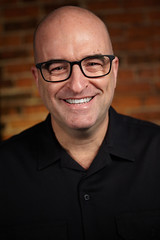 About the Interviewer
About the Interviewer
Greg Bennick (www.gregbennick.com) is a keynote speaker and long time coin collector with a focus on major mint error coins. Have ideas for other interviewees? Contact him anytime on the web or via instagram @minterrors.
To watch the complete video, see:
Julian Leidman Interview
(https://nnp.wustl.edu/library/book/626691)
To read the complete transcript, see:
Julian Leidman Interview (Transcript)
(https://nnp.wustl.edu/library/book/626692)
To read the earlier E-Sylum article, see:
JULIAN LEIDMAN INTERVIEW, PART ONE
(https://www.coinbooks.org/v26/esylum_v26n20a07.html)
JULIAN LEIDMAN INTERVIEW, PART THREE
Greg Bennick's latest interview for the Newman Numismatic Portal is with dealer Julian Leidman. Here's the third part, where Julian talks about auctions and the famous Eliasberg sale. -Editor
Greg Bennick: That's great. I love the backstory on the bidder representation, because that was something I was going to ask you about as well, because I know that you've been doing that for quite a long time, and I was going to ask you how the process works. We just got some insight into that. And then also, I was going to ask - and you gave us insight into this too - about what happens when you're representing multiple bidders at once, how you keep everyone's bids straight in your mind, and what happens if you have conflicting bids. And you just gave us a perfect example of what happens in those situations.
 Julian Leidman: Yeah. At one point, I think it was the Eliasberg Gold Sale in 1982, I was bidding
for almost 30 different people. And there were occasions where there was more than one person
interested in a coin, and I made them give me prices. Almost everybody would give me prices to
bid, recognizing that I'm going to examine the coin for them, and report back to them what I
thought about the coin, and we'd come up with a price. Harry was, of course, at the Eliasberg sale,
along with Mike and many others. It was a very, very crowded room.
Julian Leidman: Yeah. At one point, I think it was the Eliasberg Gold Sale in 1982, I was bidding
for almost 30 different people. And there were occasions where there was more than one person
interested in a coin, and I made them give me prices. Almost everybody would give me prices to
bid, recognizing that I'm going to examine the coin for them, and report back to them what I
thought about the coin, and we'd come up with a price. Harry was, of course, at the Eliasberg sale,
along with Mike and many others. It was a very, very crowded room.
Greg Bennick: I was going to ask, what was the room like? What was that like?
Julian Leidman: Unbelievable is what it was. I mean, it was absolutely packed, totally unlike auctions today. Auctions today are on the internet, and the last people that have really held live auctions have sometimes only had half a dozen people in the audience. Which is very disappointing to me as a long-time aficionado of auctions, and enjoying that, being able to see who's buying what, etc. Also at the Eliasberg sale, were Brent Pogue and his father Mack. They bought coins there too. They had been buying, really, since the late 70s. Mack was putting up all the money, Brent was just a teenager. But he had his mind on what he wanted, and it was very... as it turned out, in that sale, Harry got the 70 S three-dollar piece for $687,500, and Brent got the 1822 Half Eagle also for the same price.
So, these are both- Harry and Mack were both part of the Dallas fixture of numismatics. Of course, they knew each other, but they dealt with each other just fine. Mack was involved in real estate, and Harry was involved with oil, so they didn't have business conflicts or anything like that. But that auction in New York city for the Eliasberg gold was really something.
Greg Bennick: I'm glad you were there, I'm glad you could share a little bit about that. I just imagine a spirited room with bid cards going up, and people yelling and screaming.
Julian Leidman: Exactly. You know, when I had all those people, I didn't bother with the bid cards. I'd just bid, and then I'd look up what the number of that bidder was. I had to look up who was who. And I got coins for, I'm sure at least half a dozen or a dozen people. They all didn't get something, but that was another interesting auction in that, after the fact, I learned that there was kind of a minimum on every coin, and the Eliasberg family got back some coins after that.
Greg Bennick: Because they didn't meet the reserve...?
Julian Leidman: They were actually in the hotel watching by closed circuit, so they knew what was going on also. Many years later, I met one of Eliasberg's sons, Richard, and became pretty friendly with him. He would come to coin shows in Baltimore, because that's where his business was. But I met him there, and I did business with him subsequently. You know, I got some of the small collection of currency he had, and different things like that. But they had a subsequent sale along with Stack's Bowers in the late 90s, where they sold the non-gold coins.
Greg Bennick: Were there other auctions? I didn't plan to ask you about auctions, it's great that we're talking about it. I planned to ask about bidding for people, but not the spirit of the room, and some of these auctions. For example, I've got a set of Eliasberg catalogs - well, hurray. The energy isn't in the catalog, the energy is in your story about the catalog. Are there any auctions that you remember attending over the years, years ago, that exist now only in catalog form, that you remember as being spirited, or energetic, or exciting, or ones where there were sales that were just so memorable that they stuck in your mind?
Julian Leidman: Oh, yeah. I'd go back even to... I guess it was 1970 in St. Louis. RARCOA had the auction- I think it must have been the Central States Show, or maybe not, I don't quite remember. They had some beautiful large cents. And I remember this one large cent, 1824 over 2 large cent in uncirculated condition, went just crazy, crazy, crazy. And of course, I learned later that Ted Naftzger got that coin, and he wasn't gonna be beat out either. You remember certain auctions. Of course, over the years, I attended virtually all the Stack's auctions that were in Manhattan. I would go to New York once a month for auctions for Stack's. Lester Merkin had some gorgeous sales there. And it was just- it was part of my routine. Attending the Bowers and Ruddy sales in California, there were maybe 50 people in the room or something like that. I was a continuous buyer there.
I remember buying the 1793 half-cent because it was the first lot in every auction. I bought it two or three times because it was the first one. I'd often have pages on an invoice and stuff. Of course, the auction houses at the time, you built up your experience with them, and they would extend you a little bit of credit, and so you could work it out. But it was never really more than a month, because they normally had to settle in 45 days. And so, you could get a little bit of credit from them, and that helped me a lot at that time. There's no question about it.
 About the Interviewer
About the Interviewer
Greg Bennick (www.gregbennick.com) is a keynote speaker and long time coin collector with a focus on major mint error coins. Have ideas for other interviewees? Contact him anytime on the web or via instagram @minterrors.
To watch the complete video, see:
Julian Leidman Interview
(https://nnp.wustl.edu/library/book/626691)
To read the complete transcript, see:
Julian Leidman Interview (Transcript)
(https://nnp.wustl.edu/library/book/626692)
To read the earlier E-Sylum article, see:
JULIAN LEIDMAN INTERVIEW, PART ONE
(https://www.coinbooks.org/v26/esylum_v26n20a07.html)
ATLAS NUMISMATICS MAY 21, 2023 UPDATE
Atlas Numismatics has updated their website with 451 new coins, medals, and tokens at fixed prices. Selections include the following items: -Editor
Choice Mint State 4 Ducats of Salzburg
1074984 | AUSTRIAN STATES. Salzburg. Matthäus Lang. Prince-Archbishop 1519-1540).1522 AV 4 Ducats. NGC MS63. Edge: Plain. 13.89gm. + MATHEVS • CARDI • ARCHIEPS • SALZBVRGN. Bust, left divides date, MD - XXII / + MATHEVS • CARDI • ARCHIEPS • SALZBVRGN. Cardinal's hat and tassels above shield of arms. Fr.-591; Probszt 157; Zöttl 126 (Typ 1). Exceedingly rare. $85,000
To read the complete item description, see:
https://atlasnumismatics.com/1074984/
Copper Norodom Piastre
1075496 | CAMBODIA. Norodom I. (King, 1860-1904). 1860 CU Pattern or Trial Strike Piastre/Peso. NGC PR65BN (Brown). By Faconnet. Edge: Plain. 36.6mm. 19.2gm. NORODOM I ROI DU CAMBODGE. Bust, left; signed below truncation / UNE PIASTRE - UN PESO. Arms of Cambodia. cf. KM X-M9 (silver); Lecompte 90 (Plain edge variant). Extremely rare. $16,500
To read the complete item description, see:
https://atlasnumismatics.com/1075496/
Exceptional Spanish Armada Medal
1075502 | GREAT BRITAIN. NETHERLANDS. Holland. Elizabeth I. (Queen, 1558-1603).1588 AR Medal. NGC AU55. By Gerhard van Bijlaer (unsigned). Edge: Plain. 52mm. (rose) x DVRVMx ESTx CONTRAx STIMVLOSx CALCITRAREx [Acts IX-5]// : O. COECAS. HOMINVM. MENTES et O. PECTORA. COECA. Philip II and other Catholic heads of Church and State seated, blindfolded, with feet on spiked floor / (rose) x TVx DEVSx MAGNVSx ETx MAGNAx FACISx TVx SOLVSx DEVSx [Psalms LXXXVI-10]// : VENI. VIDE. VIVE. et (date). The Spanish fleet driven against rocks. Van Loon I, 384/1; Eimer 56a (52mm); MI 144/111; Attwood 2009 No. 1.
Defeat of the Spanish Armada. A lovely example, struck rather than cast, and with an attractive cabinet patina.
To read the complete item description, see:
https://atlasnumismatics.com/1075502/
Superbly Toned Gothic Crown
1074368 | GREAT BRITAIN. Victoria. (Queen, 1837-1901). 1847 AR Gothic Crown. PCGS PR64. By W. Wyon. Royal Mint. Edge: UNDECIMO. VICTORIA DEI GRATIA BRITANNIAR. REG: F:D. Crowned bust left / TUEATUR UNITA DEUS, ANNO DOM MDCCCXLVII. Crowned shields of England, Scotland and Ireland in cross formation with flowers at corners. KM 744; SCBC-3883; ESC-2571 (Bull); Prev. ESC-288; Dav.-106. Superbly toned with much cameo contrast evident on the devices (not noted by PCGS on the insert). $59,500
To read the complete item description, see:
https://atlasnumismatics.com/1074368/
Gem Venice Silver Ducato
1074700 | ITALIAN STATES. Venice. Alvise Mocenigo IV. (1768-69) RBP AR Ducato. NGC MS66. S. M. V. ALOY. MOCENICO. D. St. Mark seated at left presenting staff with cross and pennant at top to doge kneeling at right, mintmaster's initials in exergue /DVCATVS. VENETVS. Lion of St. Mark striding to the left, head facing forward, left paw resting on an open book, above which is a castle on a hill. KM 663; Dav.-1561. $8,500
To read the complete item description, see:
https://atlasnumismatics.com/1074700/
Colorful Benedict XV Medal
1074655 | VATICAN CITY. Benedict XV. (Pontiff, 1914-1922). AN VII (1921) AR Medal. PCGS SP64. By Aurelio Mistruzzi. Edge: Plain. 44mm. 35.95gm. BENEDICTVS XV - PONT MAX A VII. Half-length portrait to the left / DOCTORVM SCRIPTVRAE DVX CELEBRATVS// NVMERVS AVCTVS/ ANNO MCMXX. The Holy Doctors Jerome and Ephrem nimbate and seated; radiant Bible at center. Rinaldi 115; Bartolotti E 921; Cusumano Modesti 186. Struck to commemorate Encyclical Principi Apostolorum for the Proclamation of St. Ephrem Doctor of the Church. $675
To read the complete item description, see:
https://atlasnumismatics.com/1074655/
Updates to their online inventory are issued monthly. For more information and to sign up for the firm's monthly newsletter, visit: atlasnumismatics.com
THE BOOK BAZARRE
NUMISMAGRAM MEDAL SELECTIONS: MAY 21, 2023
Numismagram's Jeremy Bostwick sent along these four highlights from his most recent addition of new material. These bimonthly offerings always include an assortment of art and historical exonumia, each with a good deal of information about the respective item. For all of this upload's new additions, please visit https://www.numismagram.com/inventory. -Editor
102413 | AUSTRIA. Silver Rabbit Breeders' Club bronze Award Medal. Issued circa 1920 for special merits (36mm, 20.18 g, 12h). SILBER–KANINCHEN / RAMMLER, rabbit right / ÖSTERREICHISCHER SILBER KANINCHENZUCHT VEREIN / WEIN, FÜR / BESONDERE / VERDIENSTE in three lines within wreath. Edge: Plain. Choice Mint State. Rich red-brown surfaces, with a darker nature upon the devices that imparts a somewhat cameo aspect. $195.
A type of rabbit believed to have been introduced to England by Sir Walter Raleigh in the late 16th century, the silver rabbit has since been bred for meat and its pelt, and also for show. Along the lines of breeding for shows, clubs emerged for such showings, like the Silver Rabbit Breeders' Club in Vienna as with this award medal.
To read the complete lot description, see:
102413 | AUSTRIA. Silver Rabbit Breeders' Club bronze Award Medal.
(https://www.numismagram.com/product-page/102413)
102385 | UNITED STATES & PUERTO RICO. Christopher Columbus/Puerto Rican Expo gilt bronze award Medal. Issued 1893 as a prize for the expo and as a commemoration for the 400th anniversary of the island's discovery (50mm, 12h). By Sola y Camats & Castells in Barcelona. Draped bust of Columbus facing slightly left; in background, ship under sail right and globe with inverted anchor / ? EXPOSICION DE PUERTO RICO ? / CON MOTIVO / DEL / 4° CENTENARIO / DEL DESCUBRIMIENTO / DE LA ISLA in five lines; above, arrow left; below, horizontal laurel branch and PREMIO AL MÉRITO. Eglit 303; Storer 228. PCGS SP-64 (42214893). Extremely brilliant and alluring, with a great golden-yellow nature to the color. A very rare Columbian portrait type, and almost never encountered so enticing and problem-free. Ex David Sterling Collection. $895.
During the lead-up to the quadricentennial of Columbus's initial contact with the New World, numerous medals were designed and struck, both in the United States—in conjunction with the 1893 Columbian Exposition in Chicago—and abroad—sometimes for this event or for similar others. In this case, Puerto Rico celebrated the island's own discovery that year as well.
To read the complete lot description, see:
102385 | UNITED STATES. Columbus/Puerto Rican Expo gilt bronze award Medal.
(https://www.numismagram.com/product-page/102385)
102365 | UNITED STATES, GERMANY, GREAT BRITAIN & PERU. Christopher Columbus/Columbian Expo bronze award Medal. Issued 1893 as the official prize [awarded to the Anglo-Continental Guano Works] (76mm, 202.22 g, 12h). By A. Saint-Gaudens & C. Barber. Columbus advancing facing slightly left onto land, extending arms and with head lifted toward the heavens; to upper right, arms of Spain above CHRISTOPHER / COLVMBVS / OCT XII / MCCCCXCII in four lines / Two nude female genii seated back-to-back, one trumpeting, the other inscribing globe between them; garlanded torch to left and right; below, Santa Maria left; all around central plaque reading WORLD'S COLUMBIAN EXPOSITION / IN COMMEMORATION OF THE / FOUR HUNDREDTH ANNIVERSARY / OF THE LANDING OF COLUMBUS / MDCCCXCII • MDCCCLCIII / TO [ANGLO–CONTINENTAL / GUANO WORKS] in six lines. Edge: Plain. Eglit 90; Rulau X3. Choice Mint State. Rich red-brown surfaces, with a great glossy, lustrous nature; some scattered minor marks are noted for completeness. $465.
The Anglo-Continental Guano Works was a German-operated and mostly London-based firm specializing in the production of fertilizer from guano imported mainly from Peru—guano being the excrement of bats or seabirds, often clumping and serving as an excellent source for fertilizer, as it is high in nitrogen, phosphate, and potassium.
Featuring a nude male on the reverse supplied by Saint-Gaudens, the design was later modified to feature nude females instead, with Charles Barber offering the finished product. Though the nude male design of Saint-Gaudens was viewed as a bit too provocative by the committee in charge of approval, the design with not one, but two nude females was gladly accepted by the panel.
To read the complete lot description, see:
102365 | UNITED STATES. Christopher Columbus/Columbian Expo bronze award Medal
(https://www.numismagram.com/product-page/102365)
102387 | GREAT BRITAIN or NETHERLANDS. Painted Portrait Miniature gilt silver Oval Round. Made circa late 16th-early/mid 17th century (34mm x 42mm, 6.97 g). English or Dutch male bust facing slightly left, wearing ruffled collar. Extremely Fine. Some scattered light marks on the portrait side, though the painting is nearly entirely intact and still quite colorful. The non portrait side displays some scattered scuffs and marks. $295.
Ex: George Way Collection.
For more information on this piece, please follow this link written by the former owner: https://www.silive.com/homegarden/2011/10/many_early_artists_favored_wor.html
To read the complete lot description, see:
102387 | GREAT BRITAIN or NETHERLANDS. Painted Portrait gilt silver Round.
(https://www.numismagram.com/product-page/102387)
ARCHIVES INTERNATIONAL SALE 85
Here is the announcement for the May 23, 2023 sale by Archives International Auctions. -Editor
ARCHIVES INTERNATIONAL AUCTIONS OFFERS HISTORIC U.S., CHINESE & WORLD BANKNOTE & EPHEMERA COLLECTION ON MAY 23, 2023
The auction will be held by Archives International Auctions at their offices in River Edge, N.J.
 The May 23rd, 2023, Auction by Archives International Auctions consists of
693 lots of rare and desirable U.S., Chinese & World Banknotes, Scripophily, World Coins,
Historic Ephemera, and Security Printing Ephemera. The auction includes 301 lots of World
banknotes highlighted by 97 lots of rare and desirable Chinese banknotes and 25 lots of Canada
banknotes. Also included are over 100 lot of historic U.S. Colonial banknotes, Colonial fiscal
documents, U.S. Obsolete banknotes, Small and Large Type Notes, National Banknotes, and
miscellaneous U.S. fiscal documents. Historic and Security Printing Ephemera includes 68 lots of
rare and seldom seen items highlighted by an 1815 first account about the Battle of Orleans
during the War of 1812 that is signed by Colonel Dyer as well as dozens of historic and
interesting documents. The auction ends with 193 lots of U.S. and World scripophily.
The May 23rd, 2023, Auction by Archives International Auctions consists of
693 lots of rare and desirable U.S., Chinese & World Banknotes, Scripophily, World Coins,
Historic Ephemera, and Security Printing Ephemera. The auction includes 301 lots of World
banknotes highlighted by 97 lots of rare and desirable Chinese banknotes and 25 lots of Canada
banknotes. Also included are over 100 lot of historic U.S. Colonial banknotes, Colonial fiscal
documents, U.S. Obsolete banknotes, Small and Large Type Notes, National Banknotes, and
miscellaneous U.S. fiscal documents. Historic and Security Printing Ephemera includes 68 lots of
rare and seldom seen items highlighted by an 1815 first account about the Battle of Orleans
during the War of 1812 that is signed by Colonel Dyer as well as dozens of historic and
interesting documents. The auction ends with 193 lots of U.S. and World scripophily.
We are privileged to offer numerous rare and desirable banknotes, historic ephemera and
bonds and shares that are rarely seen at auction and include many examples we have never
had the pleasure to offer previously
, stated Dr. Robert Schwartz, President of Archives
International Auctions. Included in our 85th auction are hundreds of items that will appeal to
every level of collector and dealer
.
The auction begins with World Banknotes, from countries Afghanistan to Western Samoa,
highlighted by 97 lots of Chinese banknotes, and bonds, with a majority of these notes from an
old-time collection being offered for the first time at auction. The China banknote section is
highlighted by a Bank of China, 1912, $1, Peking
Highest Graded Branch Issue rarity; Canada
includes 25 notes including an amazing Bank of Canada, 1988, $50 DuraNote Polymer Plastic
Printer's Essay
as well as 2 additional types on DuraNote Polymer plastic of the $20, 1991
Canada issue, all are graded by PMG. Hundreds of desirable banknotes are included in this
auction that are sure to attract serious attention.
Included in the U.S. section of over 100 banknotes are 6 lots of Colonial and Revolutionary U.S. period banknotes and fiscal documents; an attractive selection of obsolete banknotes, both in issued and proof condition, with many high-grade examples offered; a Citizens' Bank of Louisiana, 1840-50s, $1000 Remainder Obsolete Banknote; Large and small type notes include many desirable and high-grade examples including Replacement notes for the Series of 1934, $1, $5 and $20 denomination Hawaii emergency issues; U.S. Emergency Issue for North Africa, Series of 1935A, features a $1, PMG Superb Gem Unc 67 EPQ example as well as dozens of other Obsolete notes, Small and Large Type notes, and depression scrip notes are included.
The historic ephemera section includes an early Louisiana Territory, 1807 Court Summons to a
witness of an alleged assault signed by early colonial notables; an 1846, Alabama estate
appraisal that includes a detailed list the estate including naming 18 slaves; a 1882, Maysville
and Big Sandy Railroad Stock Certificate signed by Confederate Civil War General John Echols; a
1931 letter signed by Thomas Watson of IBM fame as president of the Society of the
Genesee
, and dozens of other historic documents and ephemera. Security Printing Ephemera
includes 31 lots of desirable items including Advertising Notes, Progress Proof Vignettes, and
numerous related items.
Scripophily is highlighted by an extremely rare Chevrolet Motor Company specimen stock
certificate, ca. 1915, very possibly unique and the first time offered by us; a Standard Oil Trust
stock certificate, dated 1882 and signed by J.D. Rockefeller as president; an All-America
Football Conference
ca. 1930-50s membership certificate specimen; a spectacular Death
Valley Railroad Co., 1914, $100 I/U bond, as well as numerous historic and desirable bonds and
shares in various categories from mining, to railroads to banking will be offered.
Previews will be by appointment only. We will do our best to accommodate anyone who desires additional information and photographs. For questions, please call 201-944-4800 or email info@archivesinternational.com.
The online catalog for the Tuesday, May 23rd, 2023, auction is on Archives International Auctions' website and can be viewed via the Archives International live bidding platform. It can also be viewed as a Virtual Catalog or downloadable Sale 85.pdf on their website. To pre-register for Live Internet Bidding, log on to the Archives International Auctions website, at www.ArchivesInternational.com.
Archives International is now working on their late Summer and Fall 2023 auctions and are seeking quality consignments for future auctions or outright purchase including U.S. and worldwide banknotes, coins, stocks, bonds, stamps, postal history, historic ephemera, and autographs. To sell or consign one piece or an entire collection, please call AIA at (201) 944-4800; or email them at info@archivesinternational.com
TOM'S NUMISMATIC DIARY: MAY 21, 2023
I'm traveling this week and Tom Kays is covering my diary with this account from Tuesday's meeting of our Northern Virginia Numismatic Social Group Nummis Nova. Chris Neuzil was our host at Thai Luang Restaurant in Herndon. Thanks, Tom! -Editor
Nummis Nova luminaries after a bit of musical chairs, from the left, are Mike Markowitz, Lorne LaVertu, Dave Schenkman, Eric Schena, Wayne Homren, Chris Neuzil, Mike Packard, Jonas Denenberg, and Tom Kays. Not pictured is Steve Bishop.
The May 2023 Nummis Nova bacchanalia proceeded in grand style at the Thai Luang in Herndon with help from a first-time visitor and longtime Second Consul of the Ancient Numismatic Society of Washington, Mike Markowitz. Mike holds degrees in history, social ecology, and has authored many books, papers, periodic Coin Week columns, and has given TV interviews and podcasts about ancient and medieval coins, bringing his broad knowledge of the world's money from before the beginnings of coinage, up to the time of Shakespeare and beyond, to our table.
Hearing so many numismatic luminaries talking at one sitting one can lose track of the gist of many of the threads of conversation at the far end of the table. As a tangible record of what folks were talking about, I often photograph items in passing to be able to recite what I saw with accuracy and completeness but may not fully understand why I saw these great things at these dinners. Reasons why folks brought these items and why they are of interest to the reader, is left in the hands of the editor, to extract more details from diners in the week after. Some items may have no special significance but came to dinner because they showed up in our collections today. Others are the most important coins in our collections. Can you tell which is which? Seen at the May dinner were the following eclectic grouping of numismatic who'zits and what'zits:
Gold Solidus of Constantine the Great – Marking the Foundation of Constantinopolis
(a.k.a. Constantinople,
formerly Byzantium, presently Istanbul) on May 11, 330 CE from the Nicomedia Mint.
Proof-like, Austrian Holy Roman Empire – Maria Theresia Thaler of 1765 from the Hall Mint
Admiral Dewey Store Card for Engraver C. H. Hanson of Chicago
Admiral Dewey Store Card for Dr. Kings New Discovery for Consumption – Electric Bitters
- Chicago
‘One bit' (12.5 cents) Denver Colorado Mining Exchange Token of Daudel & Becherer
1703 Medal Commemorating the 80th Birthday of George Wilhelm – Duke of Brunswick and Luneburg
1778 Two Reales Hosts a counterstamp ‘Admit to the Model Artist, 127 Grand St. near Broadway'
William H. Harrison Medal To Let – Possession Given in 1841
of his fabled Log Cabin, issued for the meeting of the Young Men's Convention of May 1840
Italian Decoration for Military Valor in the southern Italian Campaign of 1860 – 1861
Admiral Horatio Nelson Battle of the Nile silver Victory at Abu Qir (Aboukir) Bay on August 1, 1798 Medalette
Arriving the day of the dinner from Baldwin's Vault was this medalette of Admiral Horatio Nelson who famously declared England expects every man will do his duty.
The British Fleet fought the French Fleet anchored at the mouth of the Nile in Aboukir Bay about 12 miles from Alexandria, Egypt. Lord Nelson ran his ships in two lines of battle both before and behind the French lines close ashore, to defeat 15 French ships with ten captured, and two burnt as this medal shares. Officers who served in Lord Nelson's fleet received silver medals for victories. Perhaps a junior officer revered this small token of esteem. It has a small blob of tar or melted metal on the reverse perhaps attesting to hot action in the war with Napoleon.
This was the smallest item in a case of British military medals including a bronze George II British Victories Medal of 1758 (Louisbourg), bronze British Victories of 1759 (Quebec), a 1783 copper Admiral Kempenfelt Blockade of Gibraltar Medal picturing the sinking of the H.M.S. Royal George (it sank in 1782 at Spithead while under repairs, but would have helped provide relief to Gibraltar, really it would), a white metal, Sir J. B. Warren, Brest Squadron Defeated off Tory Island Medal of October 12, 1798 (His fleet attacked and defeated a French squadron off the coast of Ireland) and lastly, the large medal below.
Battle of Trafalgar Memorial – Death of Lord Nelson Medal by P. Wyon in White Metal of 1805 – In Life Victorious, In Death Triumphant
Nelson's victories are listed as Bastia, Aboukir, Copenhag(en), and Trafalgar. In some small part, Nummis Nova gathers for action each month as we share stories about our collecting battles, victories and defeats. Wayne expects every diner will do his duty by sharing with the E-Sylum readers the latest news and goings-on within the numismatic community. May we have three cheers for The E-Sylum: Huzzah! Huzzah! Huzzah!
SCOTLAND'S KING MALCOLM IV COIN DISPLAYED
In the better-late-than-never department, here's an article about the display of a coin of Scotland's King Malcolm IV for the coronation of Charles III. -Editor
A rare penny that depicts a 12th century Scottish king will be put on display in honour of King Charles III's coronation.
Discovered by an amateur detectorist, the silver coin features Malcolm IV, who ruled Scotland from 1153 until his death in 1165. It will be exhibited in Dunfermline, which was bestowed city status by Charles in 2022.
The coin, which dates back to the time of Malcolm IV's rule, will be put on display near the historic Dunfermline Abbey where he was buried. Weighing under 1.5g, it will be shown in the reading room at Dunfermline Carnegie Library and Galleries until June 30.
Curator at OnFife—which manages the exhibition venue—Kirke Kook commented: "The coin is a reminder of Dunfermline's role as a seat of royal power in medieval Scotland and is the oldest Scottish coin in our collection. It also offers a rare and tantalising glimpse into the life and reign of a young king, who faces many challenges during his relatively short time in power."
The penny, which measures 2 centimetres in diameter, is believed to be only the fifth of its kind discovered. It was found in a field near the coastal town of Aberdour in Fife back in 2020.
One side of the coin depicts the bust of Malcolm IV flanked by sceptres, while the other features a medieval symbol referred to as the cross fleury.
Malcolm was only the second Scottish monarch to issue coins, with the first being his grandfather David I. It is likely that the coin was minted in the Scottish Borders, at either Roxburgh or Berwick.
Throughout the king's rule, he was dogged by ill health and was threatened by other claimants to the throne, including Henry II of England and Fergus, Lord of Galloway. Due to the fact that he only reigned for 12 years, relics related to his rule are rare.
To read the complete article, see:
Rare medieval coin depicting Scottish king to go on display in honour of coronation
(https://www.dailyrecord.co.uk/scotland-now/rare-medieval-coin-depicting-scottish-29856661)
ELEVATING NUMISMATIC STUDIES IN INDIA
This article from India calls for greater incorporation of numismatics into broader history programs. -Editor
There is no arrangement in any institution for teaching numismatics and paleography like vital sources of history. The ancient history of Jammu and Kashmir which is taught in colleges and universities has been relying mostly on the traditional sources of folklore, or on already written records. There has been hardly any effort on institutional level to look for other sources as well.
For example the paleography and numismatic like material sources have not been taken so seriously. ‘If we talk of only coins, these have perhaps been least exploited source and numismatics has remained a rather sequestered discipline in terms of the incorporation of its insights into mainstream works.
In fact it is with the efforts of few European numismatists and scholars like Rodgers, Lane Pole, Nelson Wright, Dr McDowell and Dr. Michel Mitchner others, who worked on Kashmir coinages that certain important information is available on the coins of Kashmir.
So far their research is concerned, these numismatists have not come across coins of the earlier five Sultans - Sultan Shams Shah, Jamshid, Alaudin Ali-Sher, Shahab-ud-Din and Qutb-ud-Din.
These Sultans either did not coin their money or their coins were not found. However, Nelson Wright in his catalogue of the coins in Indian Museum, Calcutta has attributed a single silver coin to Shams Shah I.
Dilip Rajgor also in his standard catalogue of Sultanate coins has mentioned single silver coin of the same king but other numismatist have questioned its identity and these experts believe it as the coin of Shams Shah II (941- 42 AH).
In view of these observations the Sultanate numismatic history emerges from the period of Sultan Sikandar who ascended the throne in 788 AH and continued up to 813 AH. In fact the earliest constant type of coinage was the standing Raja and seated goddess type. This type was introduced by a Kushan king named Kanshika in Circa 78 AD.
The Hindu Rajas and Maharajas continued their mints in this type down to the Muslim rule in 1339 AD. It served the money market for about 1261 years. However, in the later stages, the type became so much degraded that it is difficult to say which figure is intended for the standing king and which for sitting goddess on the coins of later Rajas.
This type got replaced by the Al - Sultan Al-Azani type which was introduced by Muslim Sultans in the 14th century AD. Sultans coined money in copper, silver and gold. Few brass coins of Sultan Zain-ul-Abidin are also known.
Keeping in view the scope of this subject, the history departments of various colleges and universities of Jammu and Kashmir shall create certain space for numismatics and paleography learnings.
To read the complete article, see:
Rediscovering the Sultanate Coins
(https://www.greaterkashmir.com/todays-paper/op-ed/rediscovering-the-sultanate-coins)
FAKE TOONIES FOUND IN NORTHERN ONTARIO
We've discussed before the topic of circulating counterfeits of the Canadian two-dollar coins, nicknamed "toonies." They're showing up in Northern Ontario. -Editor
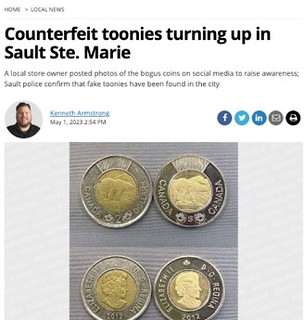 Vintage Games N Junque owner Mike Turcotte came across a suspicious 2012 toonie in Sault Ste. Marie while sorting through his cash register earlier this month. Upon closer inspection, Turcotte noticed irregularities in its design, including rough edges, recessed designs, and a dollar symbol instead of the number two on the tails side. He also observed a portrait of Queen Elizabeth II that did not resemble her usual image. Turcotte shared photos of the counterfeit coins on social media to raise awareness of their circulation.
Vintage Games N Junque owner Mike Turcotte came across a suspicious 2012 toonie in Sault Ste. Marie while sorting through his cash register earlier this month. Upon closer inspection, Turcotte noticed irregularities in its design, including rough edges, recessed designs, and a dollar symbol instead of the number two on the tails side. He also observed a portrait of Queen Elizabeth II that did not resemble her usual image. Turcotte shared photos of the counterfeit coins on social media to raise awareness of their circulation.
Counterfeit coins can have significant repercussions for businesses, leading to financial losses. Rory Ring, CEO of the Sault Ste. Marie Chamber of Commerce, emphasized the negative impact of fraud on businesses, stating that they must absorb the cash loss and fulfill their financial obligations to employees and suppliers involved in the transactions. Criminals producing counterfeit money are becoming more sophisticated by employing new technologies in their schemes. In a previous case, the Royal Canadian Mounted Police (RCMP) seized approximately 10,000 counterfeit toonies and arrested an individual on charges of uttering counterfeit money and possession of counterfeit money.
While the specific origin of the counterfeit coins found by Turcotte remains unclear, the RCMP suspected that the previously seized counterfeit toonies originated in China. They identified a distinguishing feature as a split toe in the right front paw of the polar bear design on the tails side. Although the coin discovered by Turcotte does not match this design, it highlights the ongoing issue of counterfeit coins circulating within communities. The Sault Ste. Marie Police Service confirmed their awareness of counterfeit coins circulating locally and advised individuals who come across such currency to report it to the police. Suspected counterfeit currency is then forwarded to the RCMP for verification and subsequent destruction if confirmed to be counterfeit.
To read the complete article, see:
BEHIND THE SCENES: Fake toonies found in Northern Ontario
(https://www.sudbury.com/around-the-north/behind-the-scenes-fake-toonies-found-in-northern-ontario-7000576)
To read the earlier E-Sylum article, see:
CANADIAN MAN CATALOGUING FAKE TOONIES
(https://www.coinbooks.org/v24/esylum_v24n26a29.html)
FEATURED WEBSITE: COUNTERFEIT TOONIES
(https://www.coinbooks.org/v26/esylum_v26n09a35.html)
THE 1790S BRITISH COPPER COIN SHORTAGE
On May 25th Baldwin's will be selling Patrick Deane's collection of Eighteenth Century Tokens. This article from their blog describes some Kent pieces. -Editor
William Peckham was a general shopkeeper in Appledore in southern Kent and issued his own ‘Halfpenny' in order that he could give change in the shop. He produced a marvellous coin with one side showing a lamb sleeping with a lion and a legend proclaiming PEACE, INNOCENSE AND PLENTY which is probably a sentiment based on Britain's continuing war with France and the deprivations and hardships it caused. On the other side a windmill is portrayed which would have been a common feature on the landscape at that time. The coin is copper and about 30mm wide.
In the 1790s there was no official small copper change in the country. Britain was at war with France and the price of copper had risen causing the regal issue to ‘vanish'. This caused tremendous hardship for small merchants and shop keepers throughout the country, for how were they to conduct the everyday transactions of selling small goods if they had no change. The Crown was busy with the war and any ‘unofficial' production of coin of the realm would be seen as forgery which was punishable by hanging ! Eventually a Welsh mining company hit upon the idea of turning their copper straight into pennies and halfpennies but calling them ‘tokens' that were redeemable in official coin – thus avoiding the forgery problem. As they were the correct weight, no one bothered to change them and in the space of a year, merchants in every town in England started issuing their token pence !
On the edge of the Peckham's halfpenny, pictured here, is the legend PAYABLE AT W. PECKHAM'S APPLEDORE, thus stating that it was redeemable as a halfpenny token and not an actual halfpenny !
This solved the lack of small change in the 1790s and for ten years, until the government got its act together after the war and issued official copper coins. Throughout this last decade of the eighteenth century, it is these copper ‘token' pence and halfpence one would have had in one's pocket, all over the country, as small change.
There were many merchants in Kent issuing their own coppers, particularly in the town of Canterbury, and also other smaller localities such as Sandwich, Romney marsh, Dover, Hythe, Dymchurch, Brookland, Tenterden. Staplehurst, Lamberhurst, Maidstone, Deptford, Benenden, Deal, Faversham Goudhurst, Hawkhurst Sheerness, Bromley and Chatham.
The halfpenny token used at Deal in 1794 was issued by Richard Long who was a bookseller and ran a library there. Newspapers would be sent down from London and these ‘reading rooms' were the main source of information – especially regarding the war with France! Long was fairly prominent in the town and was on the Town Council and also an agent for Kent Life and Annuity Office. His token features a man-of-war with the legend THE GUARD AND GLORY OF G' BRITAIN which had particular relevance in these troubled times. The reverse bears the cinque Port arms of nearby Sandwich.
Another bookseller and library owner issued a token in Dover, John Horn, as well as having the ‘Public reading Room' in King Street, also operated the Apollo Circulating Library which circulated that part of Kent. His establishment in King Street was not just a mere reading room but more a fashionable lounge with music and a watering hole for the gentry. On his token he featured the Prime Minister William Pitt who was also Lord Warden of the Cinque Ports and on the reverse, the Cinque port arms of Dover.
The tokens for all these Kent localities can be seen in an auction of 18th. century Tokens being held by A H Baldwin & Sons on the 25th. of May. This is one of the finest collections of these tradesmen's tokens to come onto the market in many years and each piece can be viewed on https://thestrand.com/departments/coins#upcoming-auctions They provide a marvellous window into this last decade of the eighteenth century.
Every English county is represented and nearly every English city and market town has a merchant or shopkeeper issuing their own coins and for ten years it was a truly a coinage ‘of the people, by the people, for the people'.
To read the complete article, see:
LOCAL COINAGE IN KENT: SURVIVING THE COPPER SHORTAGE OF THE 1790S
(https://www.baldwin.co.uk/news/local-coinage-in-kent-surviving-the-copper-shortage-of-the-1790s/)
WHEN WARWICKSHIRE MADE ITS OWN COINS
Here's another Baldwin's blog article based on lots in their May 25th sale of the Patrick Deane collection of Eighteenth Century Tokens. -Editor
Henry Biggs was an innkeeper in Birmingham, the ‘General Elliot' in Moore Street and issued his own ‘Halfpenny' in 1792 in order that he could give change in the tavern where he was also a licensed victualler. Not unsurprisingly, the design for his halfpenny featured the bust of General Elliot who had so valiantly defended Gibraltar against the French and Spanish some twelve years previously. The coin is copper and about 30mm wide.
In the 1790s there was no official small copper change in the country. Britain was at war with France and the price of copper had risen causing the regal issue to ‘vanish'. This caused tremendous hardship for small merchants and shop keepers throughout the country, for how were they to conduct the everyday transactions of selling small goods if they had no change. The Crown was busy with the war and any ‘unofficial' production of coin of the realm would be seen as forgery which was punishable by hanging ! Eventually a Welsh mining company hit upon the idea of turning their copper straight into pennies and halfpennies but calling them ‘tokens' that were redeemable in official coin – thus avoiding the forgery problem. As they were the correct weight, no one bothered to change them and in the space of a year, merchants in every town in England started issuing their token pence !
On the edge of Biggs's halfpenny pictured here, is the legend PAYABLE AT HENRY BIGGS'S MOORE STREET, thus stating that it was redeemable as a halfpenny token and not an actual halfpenny !
This solved the lack of small change in the 1790s and for ten years, until the government got its act together after the war and issued official copper coins. Throughout this last decade of the eighteenth century, it is these copper ‘token' pence and halfpence one would have had in one's pocket, all over the country, as small change.
There were many merchants in Warwickshire issuing their own coppers, particularly in Birmingham and Coventry and also other smaller localities such as Warwick, Meriden, Nuneaton and Stratford-upon-Avon
For Meriden there is a beautiful halfpenny token featuring the annual archery competition between the ‘Woodmen of Arden' that took place there and for Stratford-upon-Avon the halfpenny naturally features William Shakespeare.
Robert Reynolds & Co. were ribbon weavers in Coventry and produced a very elegant token in 1792. One side shows an almost naked Lady Godiva on a horse whilst the other side portrays the arms of Coventry, an elephant and castle.
The tokens for all these Warwickshire localities can be seen in an auction of 18th. century Tokens being held by A H Baldwin & Sons on the 25th. of May. This is one of the finest collections of these tradesmen's tokens to come onto the market in many years and each piece can be viewed on https://thestrand.com/departments/coins#upcoming-auctions They provide a marvellous window into this last decade of the eighteenth century.
Every English county is represented and nearly every English city and market town has a merchant or shopkeeper issuing their own coins and for ten years it was a truly a coinage ‘of the people, by the people, for the people'.
To read the complete article, see:
WHEN WARWICKSHIRE MADE ITS OWN COINS
(https://www.baldwin.co.uk/news/forging-change-currency-innovation-in-the-1790s/)
BALLYKINLAR INTERNMENT CAMP TOKENS
From the Irish website The Old Currency Exchange we have this article on the tokens of the 1920s Ballykinlar Internment Camp. See the complete webpage for more information. -Editor
In the aftermath of Bloody Sunday, 21 November 1920, the British authorities arrested hundreds of republicans and opened several internment camps throughout Ireland.
- The first internment camp to be opened was at Ballykinlar, in Co Down
- The volume of arrests was so great that additional camps had to be established at Gormanstown, Co Dublin, Bere Island and Spike Island, Co Cork, and at The Curragh, Co Kildare.
Opened in December 1920, Ballykinlar Camp was situated on the Co. Down coast at the mouth of Dundrum Bay, about three miles from Dundrum village between Downpatrick and Newcastle.
Three days later after the signing of the Anglo-Irish Treaty, on 9th December 1921, all republican prisoners were released from Ballykinlar. Three special trains brought the men to Dublin, from where the internees made their own way to their home counties.
Ballykinlar Internment Camp Tokens
There are 6 denominations known (one penny, threepence, sixpence, one shilling, five shillings and one pound) and each have variations for use in Camp No. 2 – the second of the two main compounds built and extended to hold IRA prisoners during the aftermath of the 1916 Rising in Dublin and, later, those involved in the Irish war of Independence 1919-21.
- The tokens were first issued circa. 1920
- They were in use within the camp until the release of the prisoners on 9th December 1921
- There are seven denominations, i.e. 1d, 3d, 6d, 1/-, 5/-, 10/- and £1
To read the complete article, see:
(https://oldcurrencyexchange.com/2015/11/13/obrien-coin-guide-ballykinlar-internment-camp-tokens-1920-21/)
WATERY ORIGIN OF AMERICA'S LARGEST BANK
This didn't make the cut last week, but I wanted to share this interesting article on the origin of one of the largest banks in the world, JPMorgan Chase. There's a numismatic connection of course, and here it is. -Editor
In the 1790s, New York City suffered a yellow fever outbreak basically every year. The mechanism of disease outbreaks (cholera was another common one in cities) wasn't understood, but somehow people realized that having stagnant wastewater sitting in gutters wasn't great, and that clean drinking water would be nice. So the city's Common Council proposed a publicly constructed water system.
Enter former New York attorney general; former U.S senator from New York; former (unsuccessful) vice-presidential candidate; and newly minted head of the New York State Assembly: Aaron Burr — part of a group of newly elected anti-Federalists.
Burr pushed a proposal made by his doctor brother-in-law, Joseph Browne, to privatize water delivery. Browne proposed a company that would pipe fresh water into Manhattan from the Bronx River and charge households $10 per year for 30 gallons of daily fresh water. (If a household only wanted access to water for use in firefighting: $2 per year.)
In order to convince the Federalists on the Common Council, Burr enlisted his archrival, Mr. Federalism himself, Alexander Hamilton, as an ally,
as economist Edward Glaeser put it. Hamilton was concerned that the city wouldn't be able to pay for the project, and so got on board with a private company; the city would have the ability to buy a large chunk of shares, and to have representation on the board of directors. And thus, The Manhattan Company was authorized in the spring of 1799.
Except Burr managed to slip in some rather important changes at the last minute. (Guess Hamilton wasn't in the room where it happened.) According to Maura Ferguson and Sarah Poole, who co-curated the Museum of American Finance's Ebb & Flow: Tapping into the History of New York City's Water
exhibit, the crucial clause was in paragraph nine of the company's charter:
And it be further enacted, That it shall and may be lawful for the said company to employ all such surplus capital as may belong or accrue to the said company in the purchase of public or other stock, or in any monied transactions or operations not inconsistent with the constitution and laws of this state or of the United States, for the sole benefit of the said company.
In other words, the water company could use surplus funds for financial operations of its choosing. By the fall of 1799, most of the company's cash was being used for the Bank of the Manhattan Company. As Ferguson and Poole wrote:
"In effect, it provided Burr with a Republican bank to rival Hamilton's Federalist Bank of New York.
"
Whoops, Alexander.
The company didn't end up fulfilling its water mission. Rather than piping in water from the Bronx, it used ground wells — some of which weren't sanitary — and didn't provide nearly enough water for a growing city. The company also didn't repair streets after laying pipe, which led to a legal fight with the city. Ultimately, Ferguson and Poole add:
Burr's deception about his intentions to start a competitor bank with the Manhattan Company was one of the many disagreements between [him and Hamilton] that eventually led to the duel.
It wasn't until the 1830s that the Croton Aqueduct was created, and finally gave New York City reliable, clean water distribution.
For a final fascinating (and funny) paragraph, back to Ferguson and Poole:
After the Croton System opened, the Manhattan Company waterworks emptied out and was torn down in the early 20th century. To maintain its state charter, water was pumped by a bank employee at the site every day until 1923. The Bank of the Manhattan Company is the earliest predecessor of today's JPMorgan Chase, the largest bank in the United States. In 1965, Chase Manhattan was granted a federal charter that was no longer dependent on providing clean and wholesome water.
To read the complete article, see:
Hamilton + Burr = JPMorgan Chase
(https://davidepstein.substack.com/p/the-watery-origin-of-jpmorgan-chase)
For additional articles on NYC water history, see:
The Contentious History of Supplying Water to Manhattan
(https://www.mcny.org/story/contentious-history-supplying-water-manhattan)
How New York City Found Clean Water
(https://www.smithsonianmag.com/history/how-new-york-city-found-clean-water-180973571/)



